Mycenae: From Myth to History
An exhibition of photographs by Robert McCabe
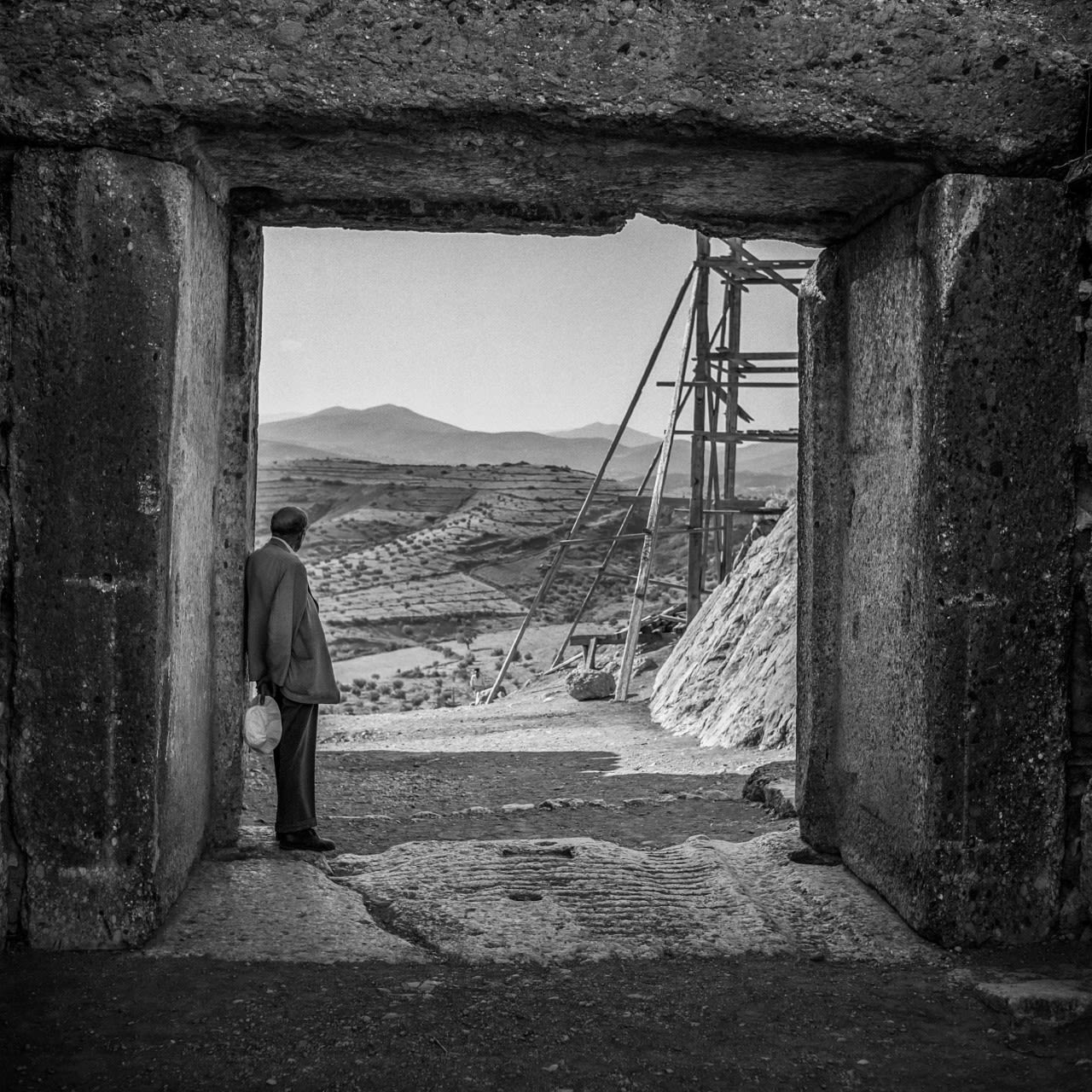
In the summer of 1955, Robert McCabe, a young American in his early 20s, was given a simple assignment by Professor Alan John Bayard Wace: to create a visual record of Mycenae with his Rolleiflex camera and Plus-X film.
Wace had led British excavations at Mycenae since he was personally granted permission to do so in 1920, as Director of the British School at Athens.
McCabe took some 200 photographs that year, a small number perhaps by modern digital standards but a sizeable and comprehensive record nonetheless. This exhibition features around fifty of those photographs, capturing a black and white archive of the site and its place in the broader landscape – a landscape peopled in McCabe's photographs by both archaeologists and locals alike, whose interactions and stories are remembered in the captions.
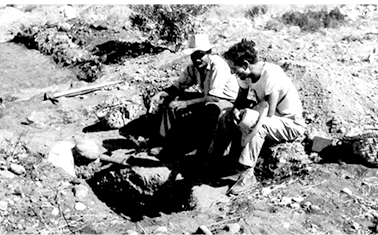
Robert McCabe in 1955 with Nikolaos Demopoulos
Robert McCabe in 1955 with Nikolaos Demopoulos
Panoramic view of Mycenae and the surrounding landscape. This image is an early panoramic photograph, made from two photographs knitted together. At the left end, the entrance to the Treasury of Atreus also known as ‘Tomb of Agamemnon’, one of the nine Mycenaean tholos tombs at this site, is visible. At the right end is the citadel of Mycenae.
The photographs in this exhibition offer an insight into the meeting of myth and history. Mycenae holds a special place in both Greek myth and Greek history. The stories of its people and its kings are woven through ancient storytelling, from Homer's Iliad to the tragedies of Aeschlyus and Sophocles, and beyond. Those stories tell of a distant past, of a city ruled by a family riven with discord and treachery: Agamemnon, who led the Greek forces against the city of Troy in defence of his brother Menelaus' honour, only to be killed upon his return home by his own wife, Clytemnestra, and her lover.
The archaeological site itself is located in the north-east Peloponnese in Greece. Mycenae was a powerful Bronze Age centre of production and administration, with dominance over the surrounding territories.
The remains of a palace complex, with temples, storerooms, craft workshops and housing surrounded by imposing fortified walls, are testament to a flourishing city. Beyond the citadel, tombs and roads linked the centre to its locality and beyond, since the city controlled trade routes over both sea and land.
In 1999, UNESCO deemed Mycenae to be a world heritage site, highlighting the impact the site had and continues to have on European art and literature for more than three millennia. 2020 marked the centenary of the British excavations at Mycenae, under the directorship of Alan Wace.
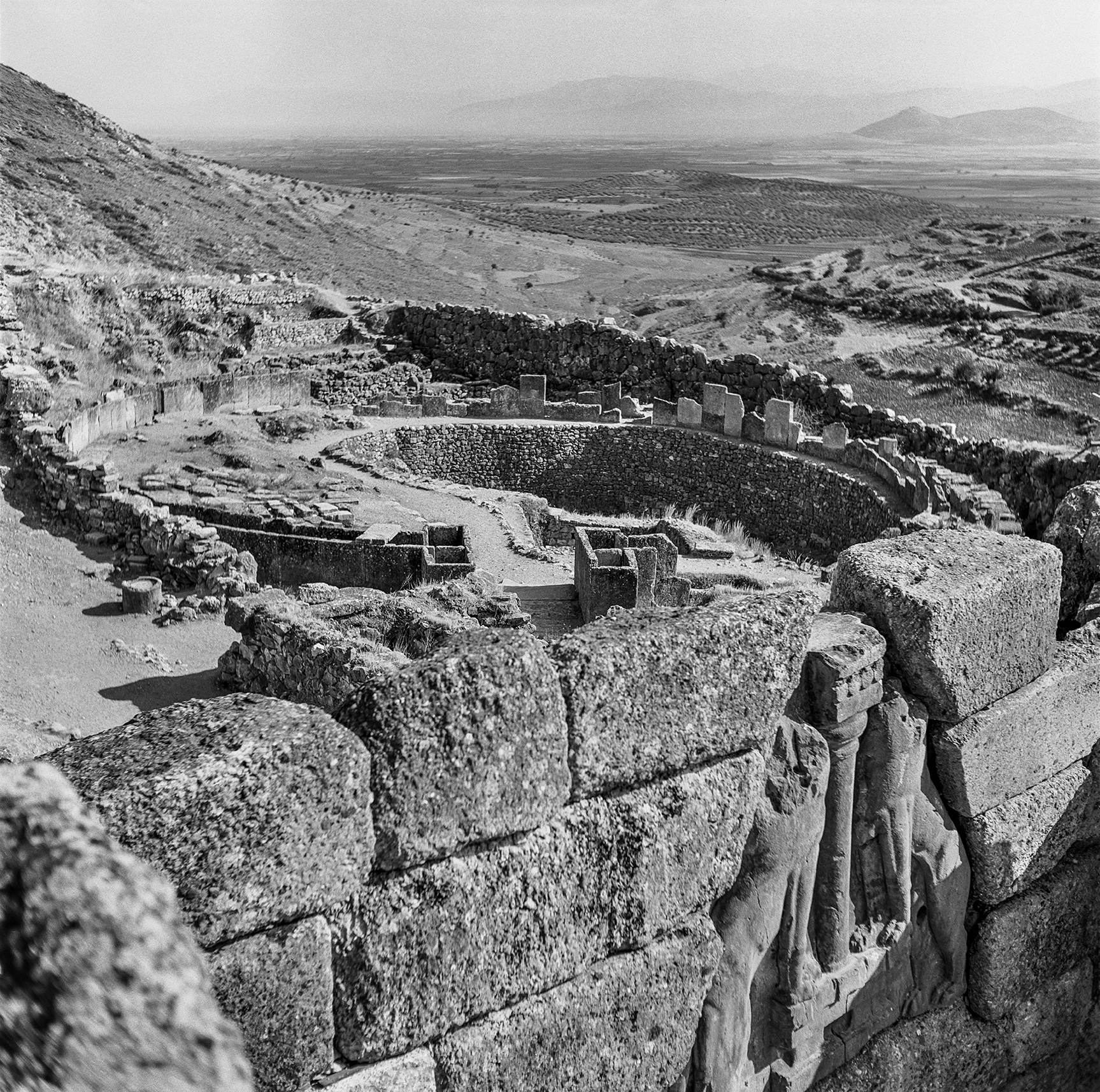
From the top of the East Bastion of the Lion Gate there are many magnificent views across Grave Circle A and over the Citadel Wall to the Treasury of Atreus and the plain of Argos, stretching beyond to the two hills of Argos, the peaked Larissa and the flat Aspis (shield).
Remembering the summer of 1955
The assignment to photograph Mycenae had an unusual genesis. I had made my first trip to Greece in 1954 and had taken a few photographs of Mycenae. Prof Wace came over from the Institute for Advanced Study for a look when they were displayed at Princeton’s Firestone Library in the spring of 1955. After examining the photos and noting a misspelling in our attempt to write ‘Mycenae’ in Linear B, he asked if I would come to Mycenae that summer and take photographs.
When I arrived at the British School, Professor and Mrs Wace invited me to accompany them on a tour of the Peloponnesus. I considered it an enormous honour for someone who had just completed their junior year, and had been rejected by the Classics Department because I knew only Latin and not Ancient Greek.
We travelled in an old Athenian taxi. The Waces had two major objectives. One was to visit Carl Blegen at Pylos and inspect the bathtub he had recently uncovered. The other was to find the site of the Palace of Menelaus. For two days we hiked around the hills southwest of Sparta ‘oxyderking’ (a word Wace made up to describe an intense survey) for traces of the Palace. Unfortunately we found nothing encouraging on that visit.
At Pylos, when Blegen heard I had camera he grew fearful that it could lead to an unintended leak to the press about the bathtub. So my camera sadly was barred from the site. But it did give me an opportunity to photograph and get to know Piet de Jong working at the Chora museum, and also to take a long hike on Sphakteria.
Remembering Alan Wace
Alan John Bayard Wace (13 July 1879 – 9 November 1957) was one of the leading archaeologists of early Greece in the 20th century. He features as a strong and noticeable presence in McCabe's photographic landscape, a tall figure framed by the archaeological features he studied and excavated. Permission to excavate Mycenae was granted to Wace, as director of the British School at Athens (1913-1923), personally by Christos Tsountas on behalf of the Archaeological Society of Athens in 1920. The dig began on 23 April 1920.
Wace directed the excavations at Mycenae until 1955, the year he met Robert McCabe. In the intervening years, he had strong links with Cambridge. As a student, he had read the classical tripos at Pembroke College, and he returned to become the Laurence Professor of Classical Archaeology, a position he held from 1934-1944.
Today, both the Mycenae Excavation and Publication Archive and the Alan John Bayard Wace Professional Archive are held at the Faculty of Classics Archive and have been partially digitised.
Read more about Digital Mycenae, celebrating 100 years since Wace first broke ground at Mycenae.
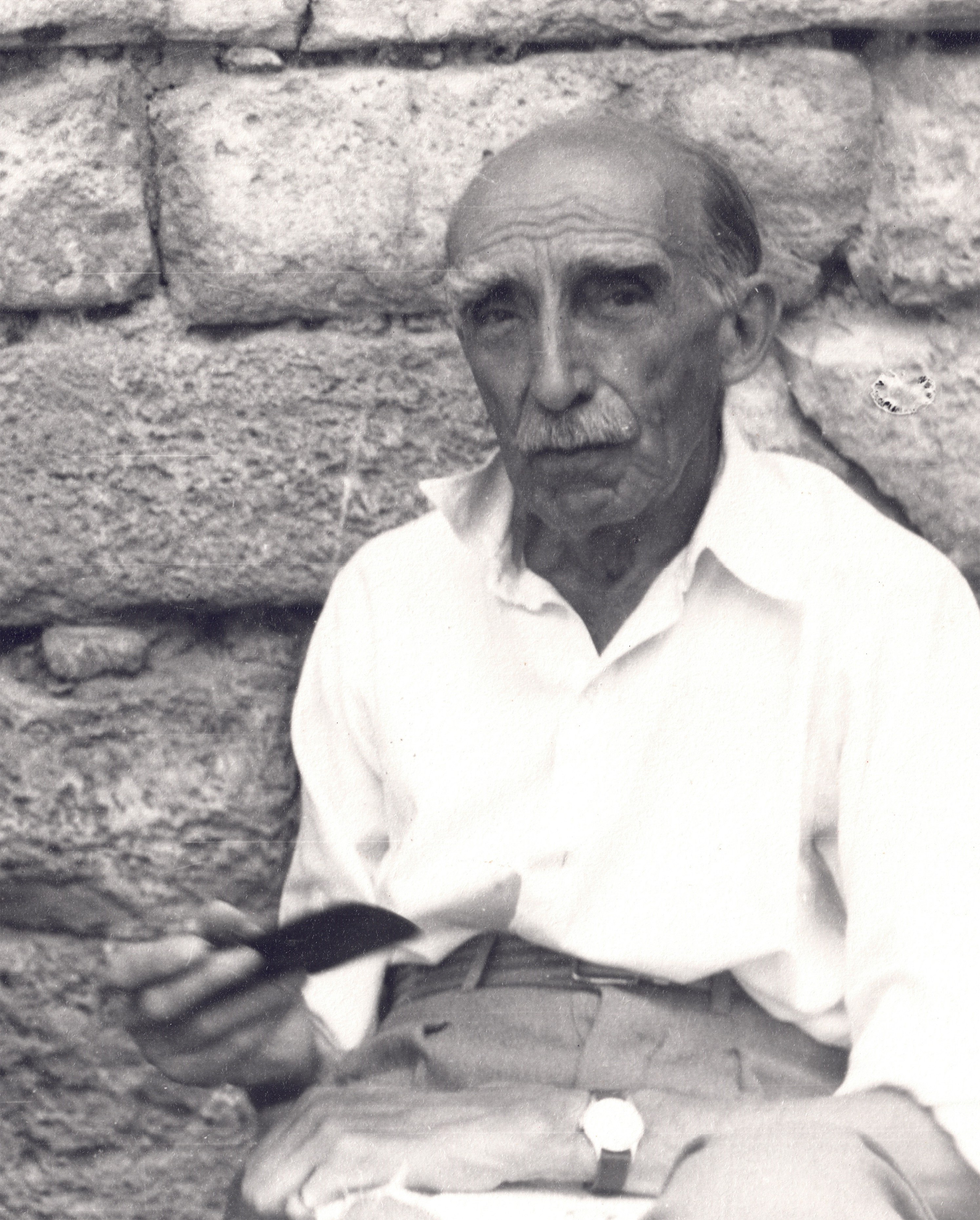
Alan Wace during excavation work on the Panagia Ridge. The excavation team can be seen starting work in the foreground with Christos Brekos, who served as assistant to the architect for many years, holding the survey staff in the background. Noticeable are the thick head scarves on two of the older men; these were all-purpose squares of striped homespun cloth that could be used as aprons, cummerbunds, head scarves, or for carrying lunch.
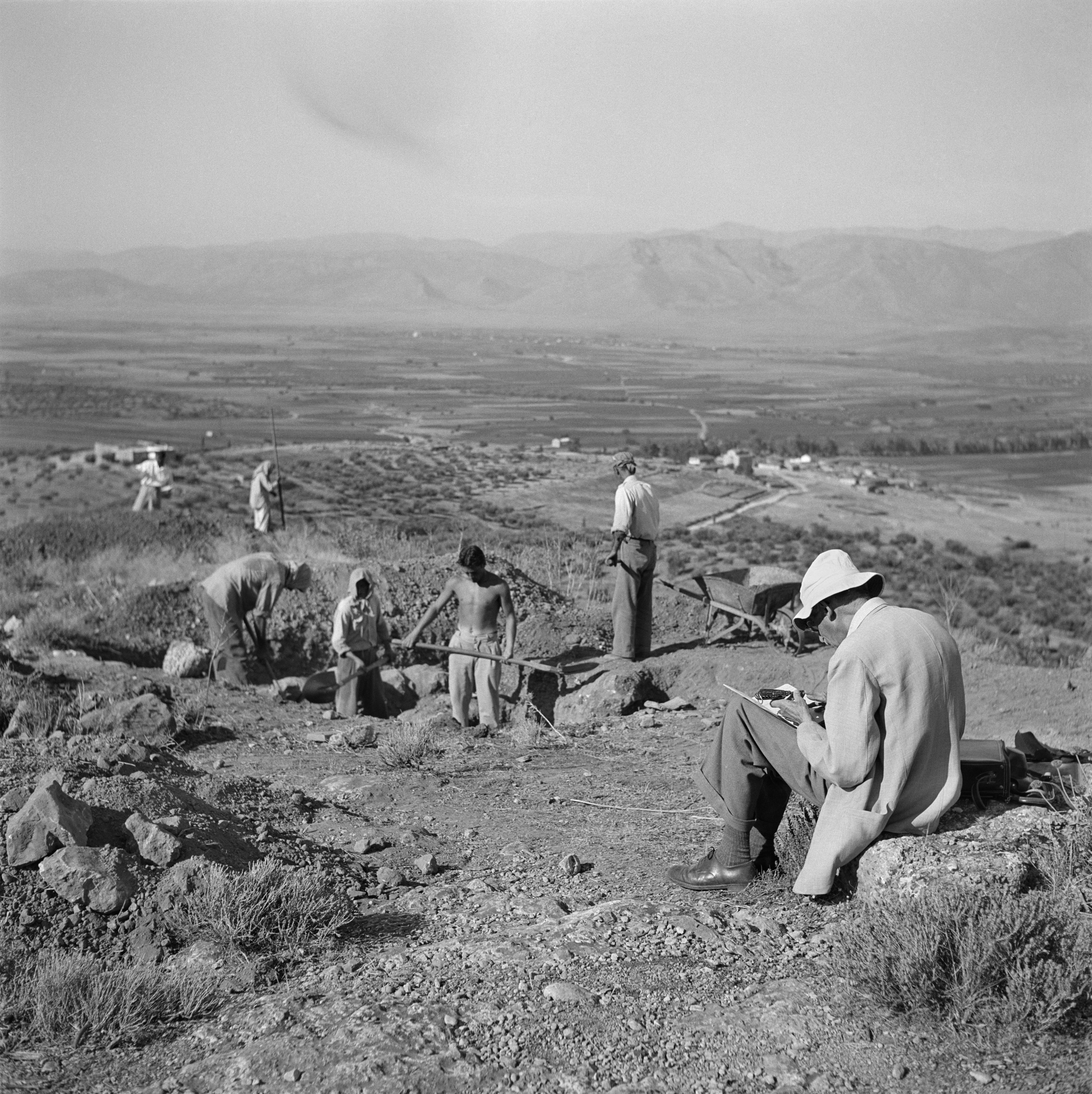
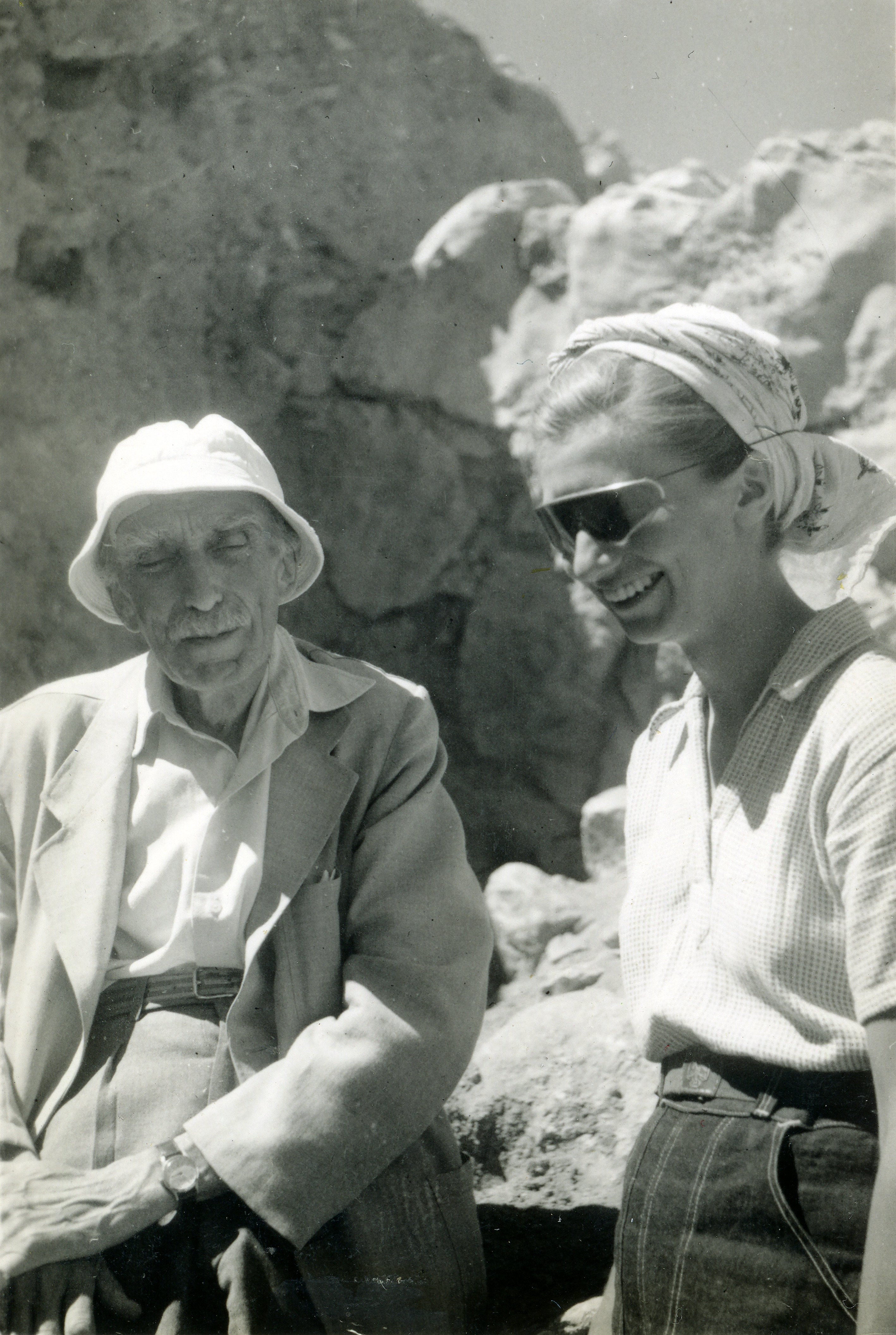
Remembering Lisa (Elizabeth) French
Elizabeth Bayard French (née Wace, 19 January 1931 – 10 June 2021) was the daughter of Alan and Helen Wace – and she carved out a ground-breaking career as an archaeologist. Following in her father's footsteps as a world-renowned expert on Mycenaean figurines, she would also become the first female director of the British School at Athens from 1989-1994.
Lisa, as she was known, first joined Wace's excavations at Mycenae in 1939, when she was aged 8. She went on to excavate there alongside her father from 1950-1957, starting while she was still an undergraduate reading Classics at Newnham College, Cambridge. Following his death, she continued to excavate at Mycenae alongside Lord William Taylour and George Mylonas until 1967. She was joint editor of the Well Built Mycenae series of books, and in 2013 she donated the archives of the excavations at Mycenae, as well as her own professional archive, to the Faculty of Classics in Cambridge.
Image of Lisa French courtesy of the French Family Archive
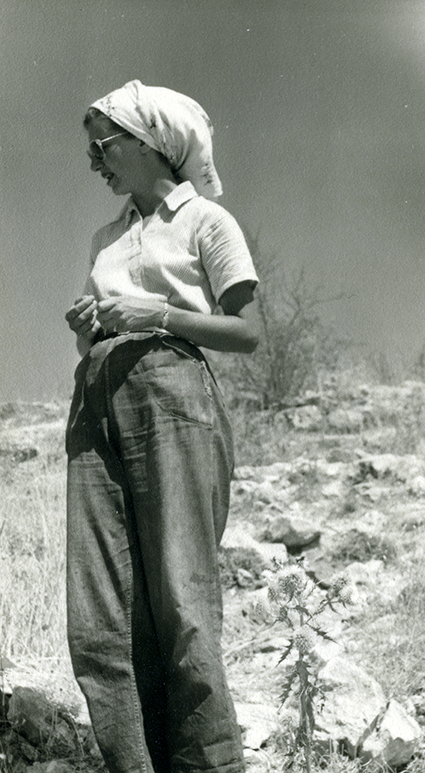
About this exhibition
Robert McCabe was born in Chicago in 1934 and grew up in Rye, New York. He began taking photos when he was five, when his father gave him a Kodak Baby Brownie.
Over the past two decades, his photographs of Greece have been exhibited in both Europe and the US. In 2020, he was granted honorary Greek citizenship.
All images © Robert McCabe unless otherwise stated.
The captions accompanying the photographs were written by Elizabeth (Lisa) French.
The captions are her reminiscences, memories of digging alongside her father but also of the many people who made the dig possible.
Christos Manos and his mother Sophia, photographed at their encampment on the slopes of Mount Prophet Ilias. The family had a long tradition as shepherds.
Newly moulded mud bricks spread to dry high on the north edge of the modern village.
View through the Sally Port on the South side of the Acropolis wall. It opens onto a small terrace overlooking the Chaos Ravine which runs between the Citadel and Mt Zara.
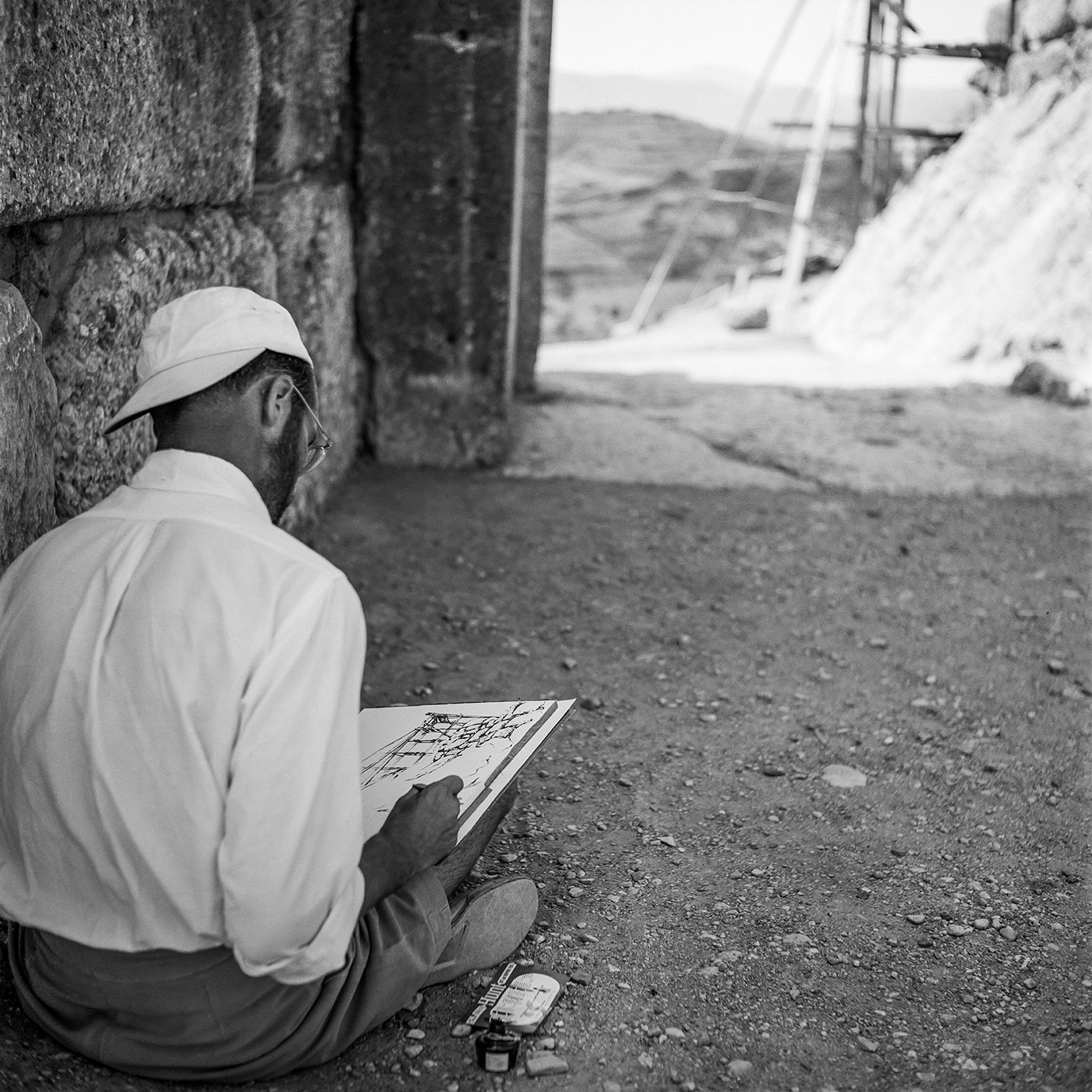
Charles Williams (excavation architect 1955) sketching, sitting in the shade of the Lion Gate.
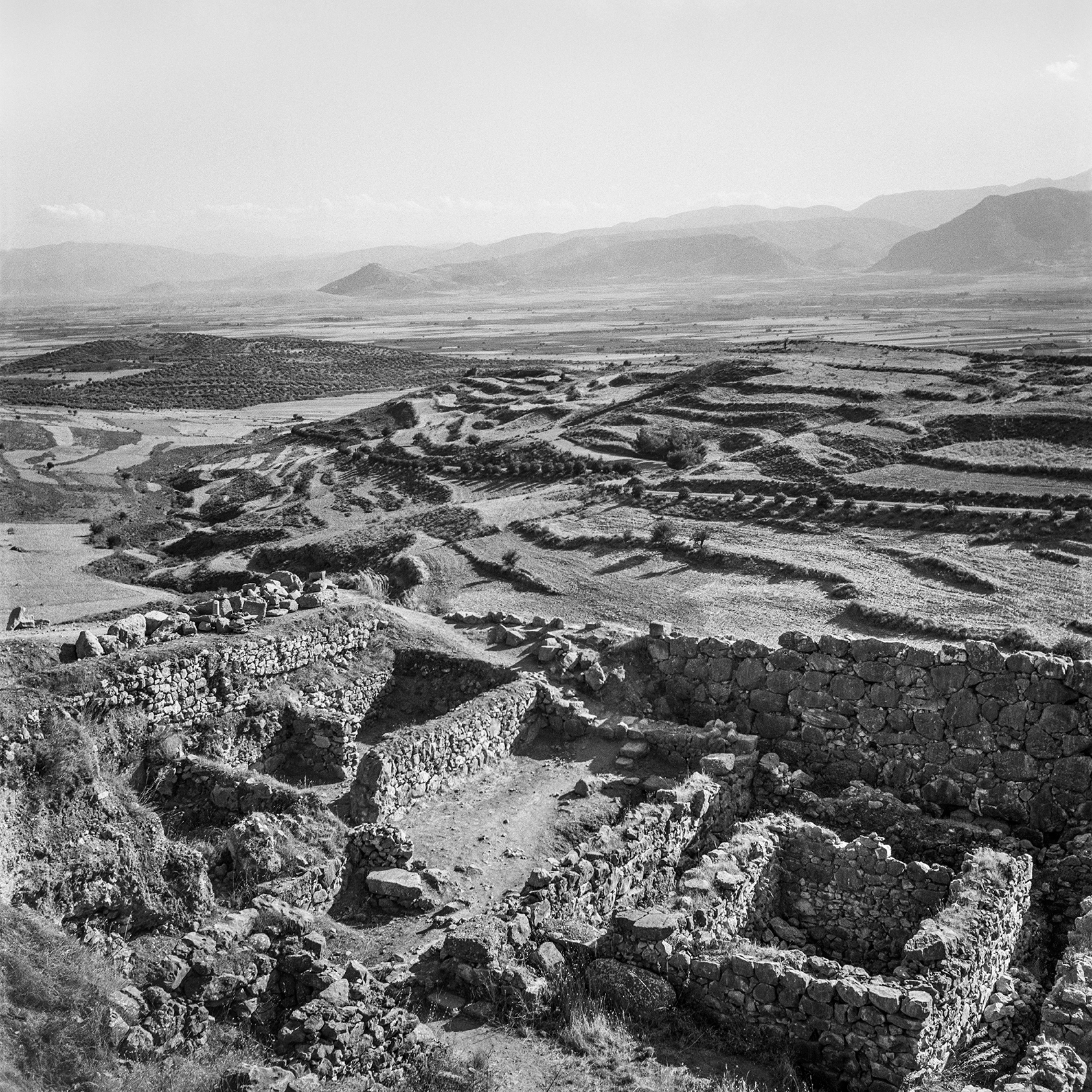
From the top of the Great Ramp looking across the House of the Warrior Vase and the South House towards the treasury of Atreus and Argos.
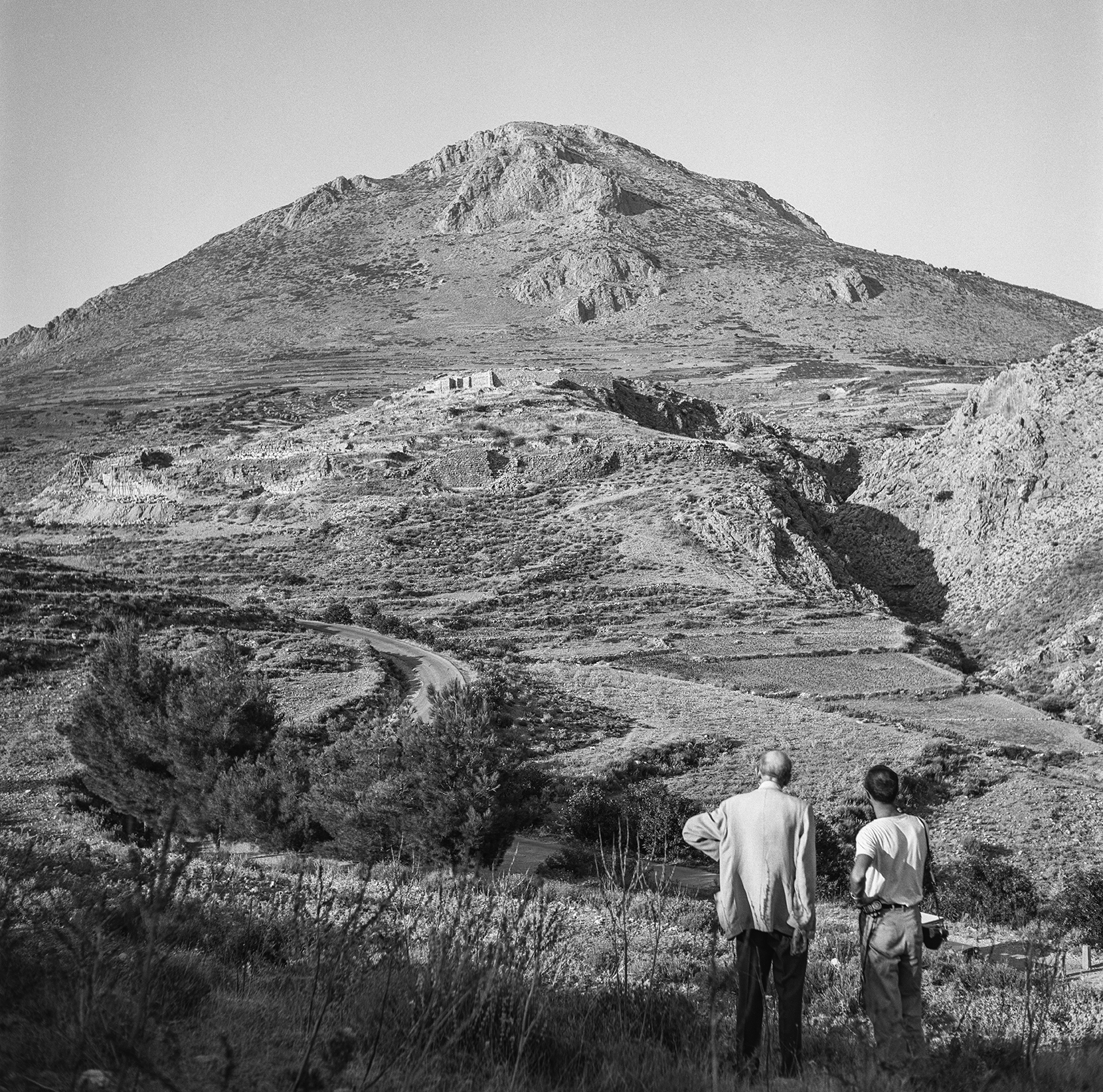
Alan Wace with the excavation architect for 1954, Herschel Sheppard, looking towards the Acropolis and Mount Prophet Ilias from beside the modern road to the west.
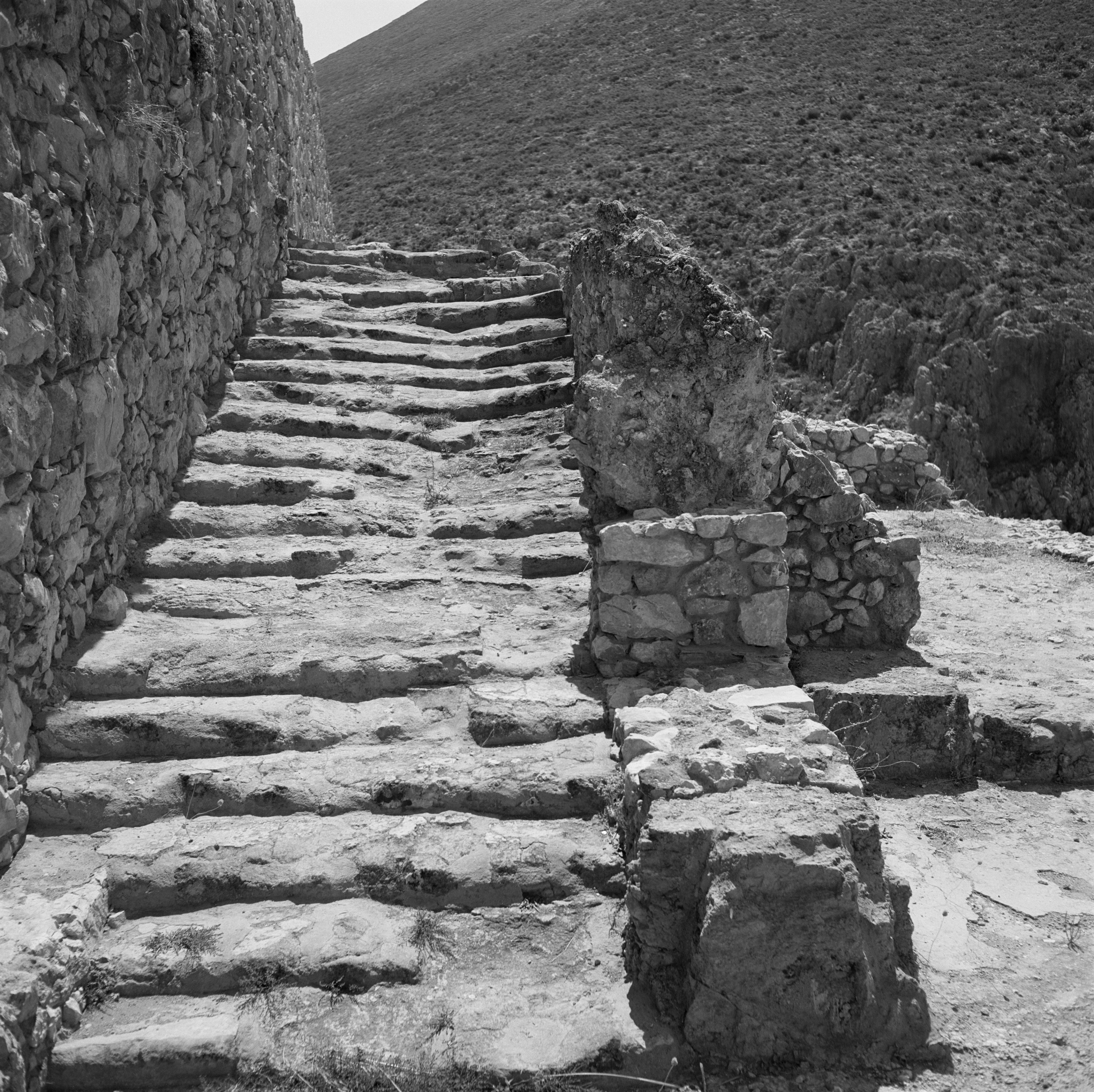
The Grand Staircase that led to the Palace Court.

Repairing the excavation jeep in Argos. Jeeps left behind by the military became useful all-purpose excavation vehicles – that of Carl Blegen at Pylos was even found to have a live hand grenade under the driver’s seat. Argos was the local market town where anything and everything would be sought and usually obtained.
The mechanics were particularly good. Large trucks like that in the photo were used to convey overnight fruit and vegetables from the rich gardens of the Argolid to the markets of Athens. Often trucks formed part of the dowry given to a young bride to enable her husband to set himself up in business.
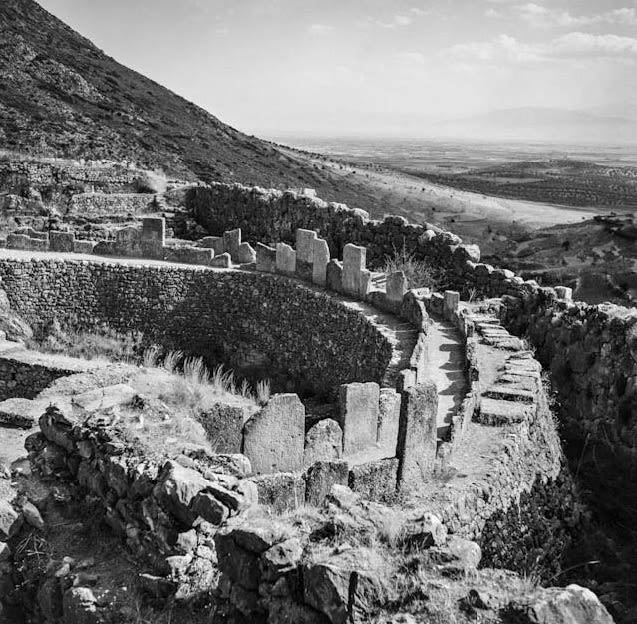
The west side of Grave Circle A in morning light with Mount Zara in the background. .
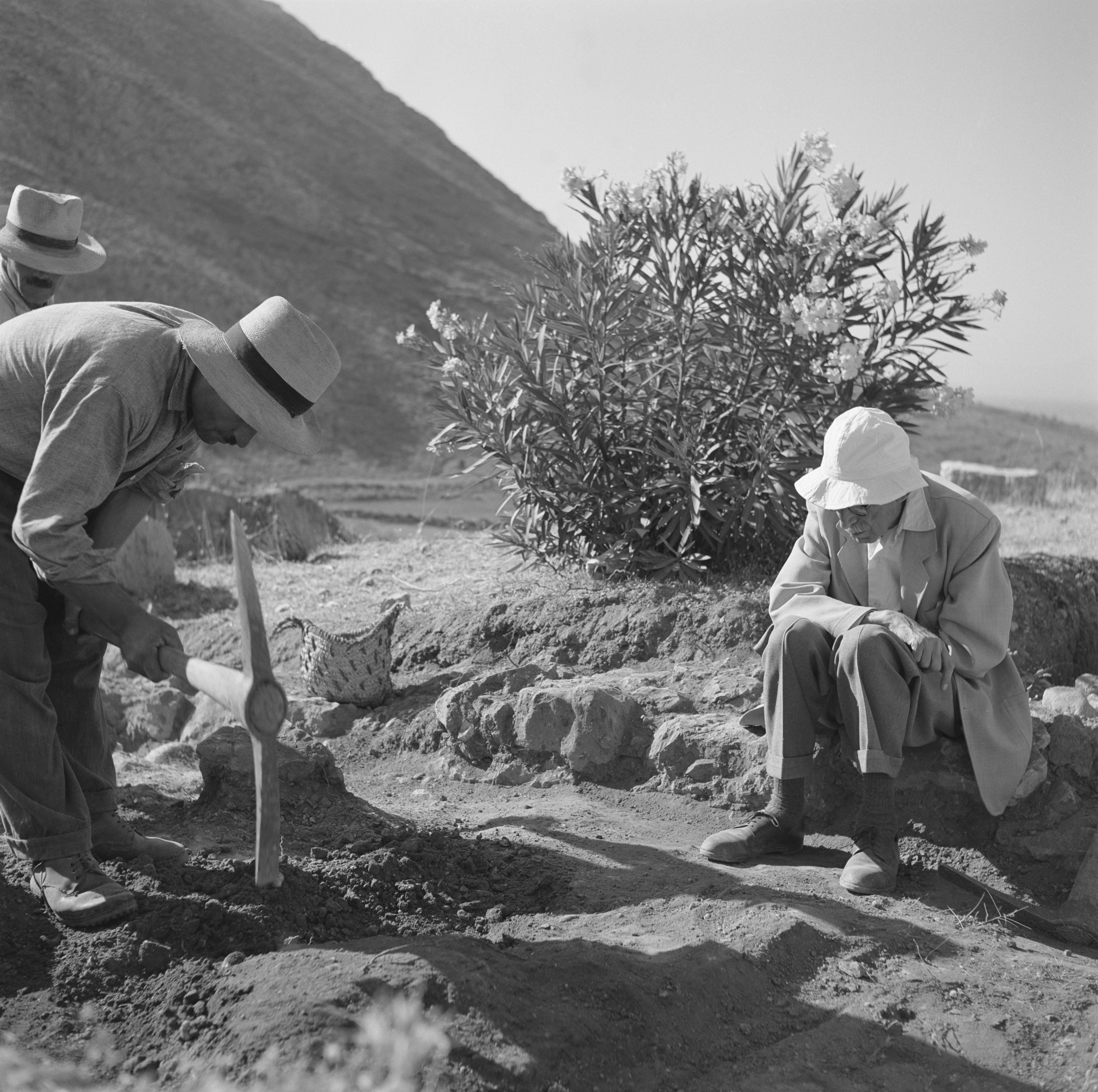
Alan Wace observing one of Mycenae’s skilled pickmen (Dimitris Papadopoulos) opening a new trench on the slope west of the modern road, across from the House of Shields and the House of the Oil Merchant. Some villagers had worked for Alan Wace in the excavations of the 1920s, others were recent recruits. Many became exceptionally skilled with the small pick (skalistiri).
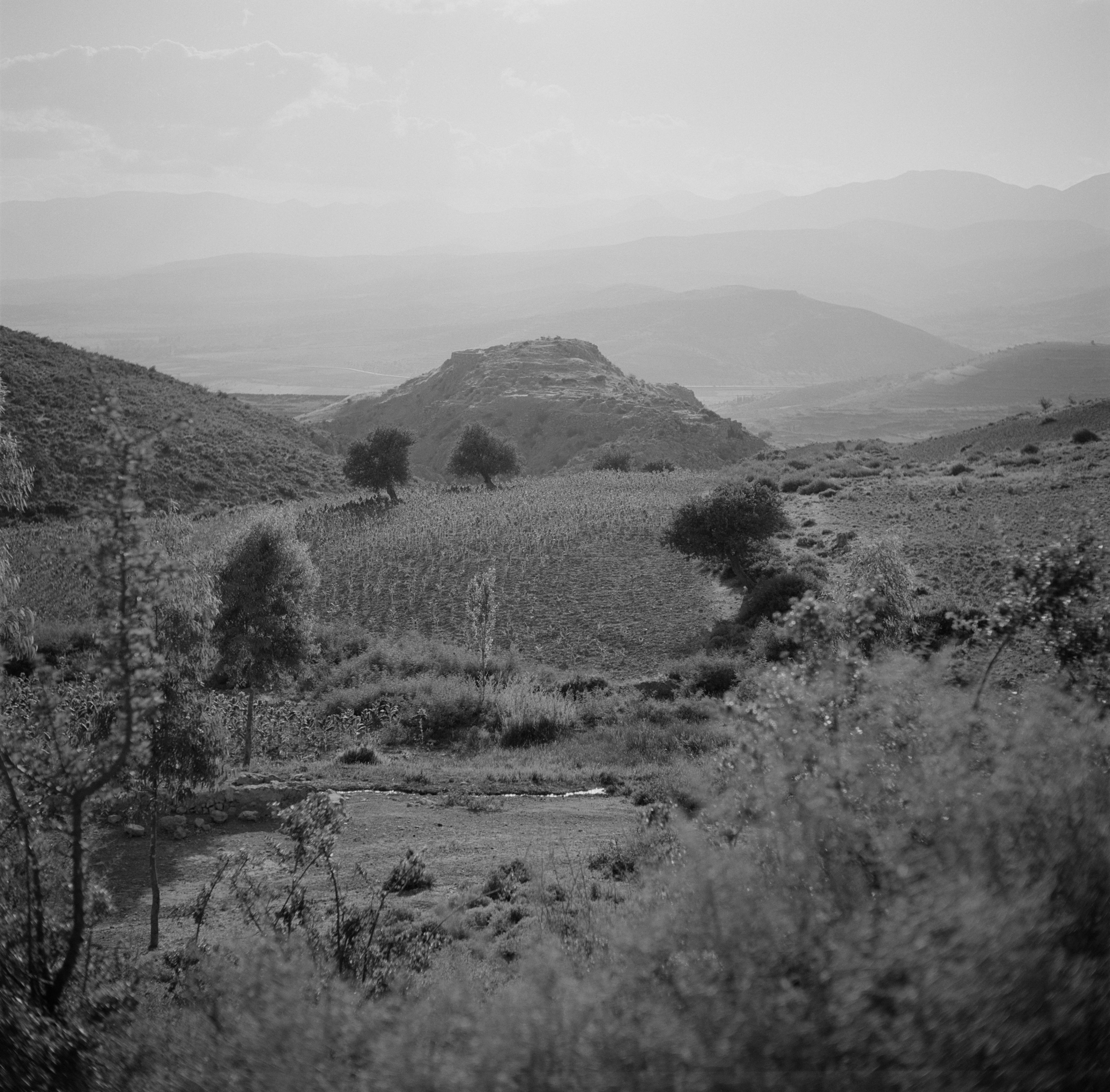
The distant view of the Acropolis from the east for the traveller coming from the northeast or from Berbati.
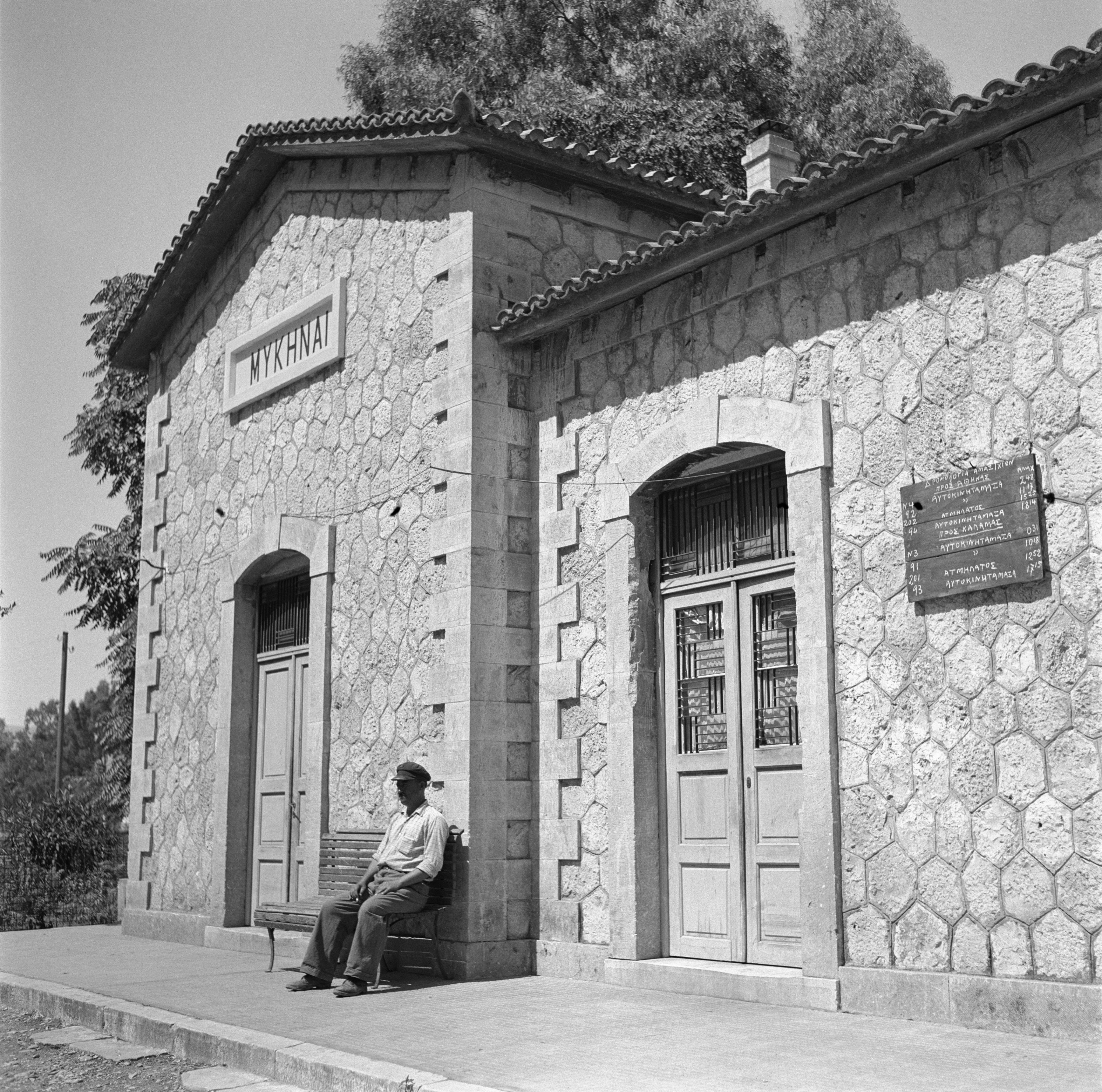
The stationmaster Theodosios Papadopoulos relaxes at Mycenae station (at the village of Phychtia on the main road from Corinth). The board shows the timetable of the Up trains to Athens and the Down trains to Kalamata; both the fast autokinetamaxa (automatrice) and the slow atmelatos (steam trains) are listed. Today there is no train service to Mycenae.
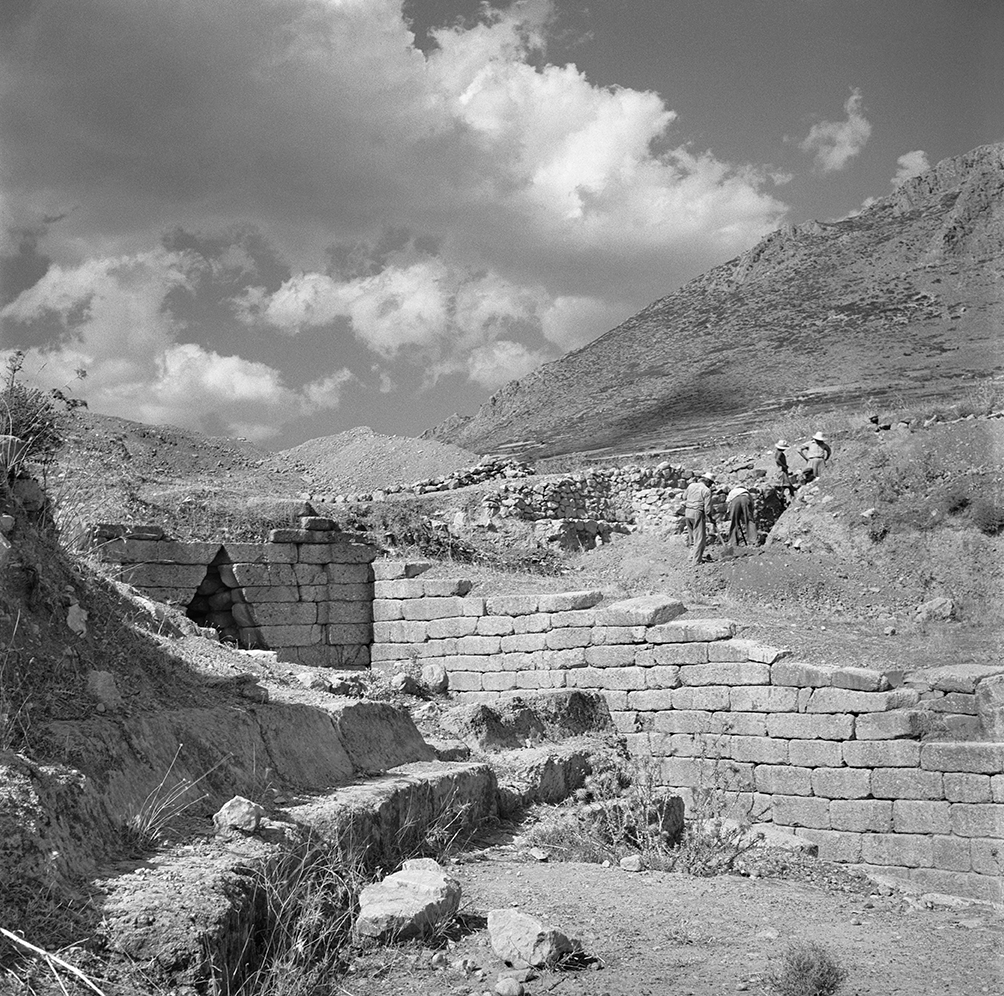
Looking northeast across the dromos of the Tomb of Clytemnestra. Seats of the Hellenistic theatre are visible in the foreground and excavation of the Poros Wall, which capped the outside of the tomb, can be seen the other side of the dromos.
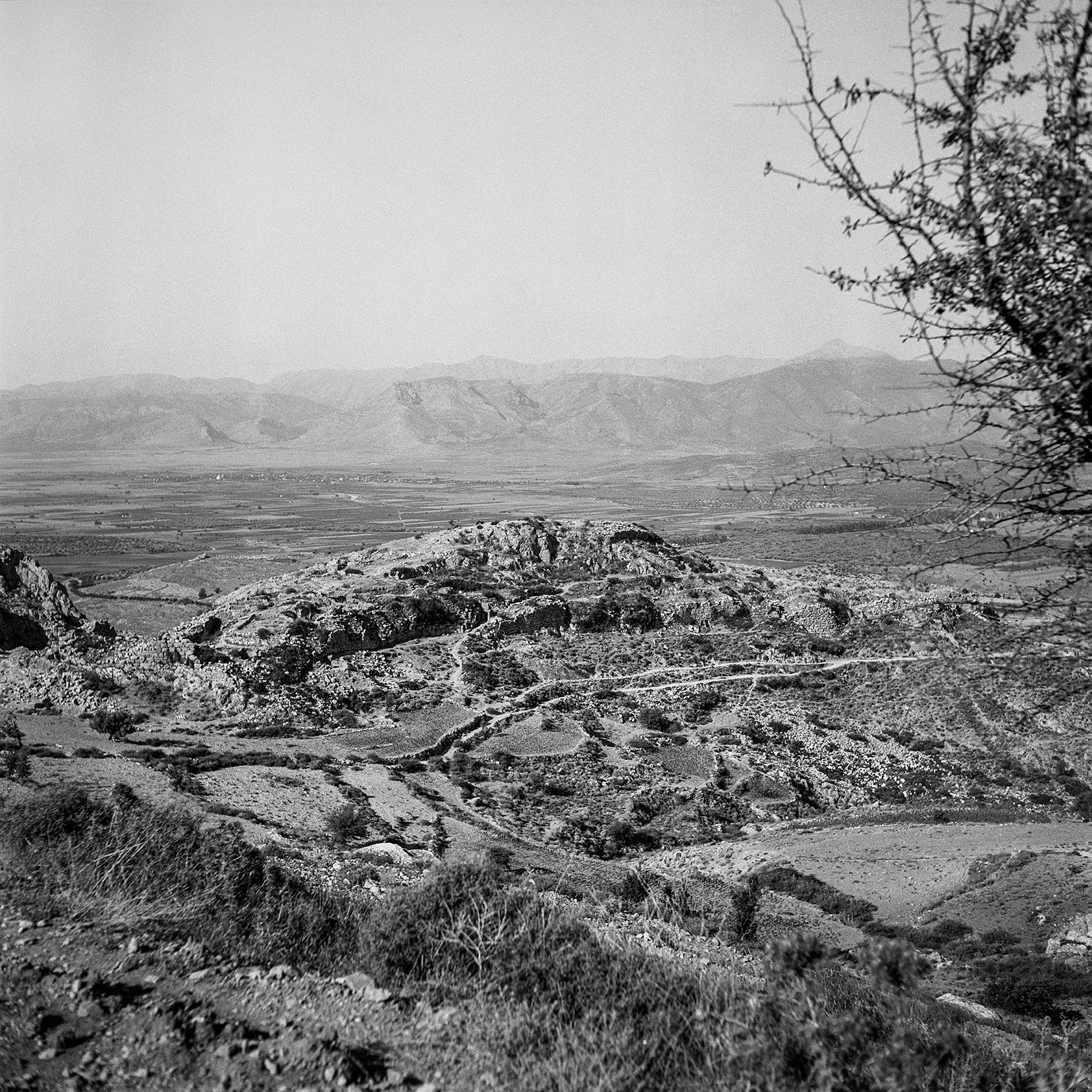
The Acropolis of Mycenae from the northeast seen from somewhat higher on the slope of Mt. Prophet Ilias. The north end of the Argive plain and the modern road to Corinth can be seen beyond. The Mycenaean road to the southwest led directly across the plain towards Argos passing the farmstead at Khania on its route.
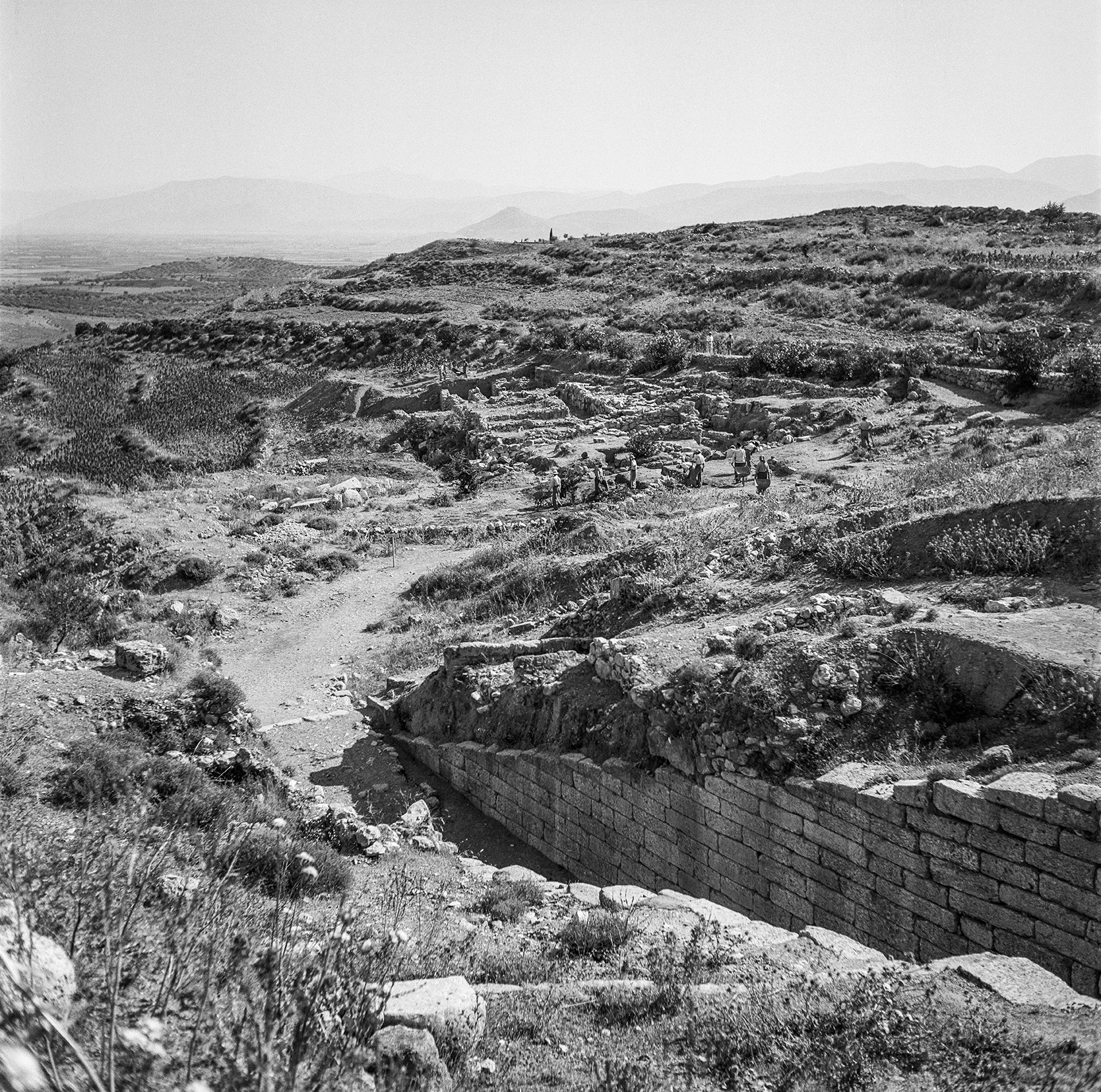
Looking southwest across the dromos of the Tomb of Clytemnestra. The seats of the Hellenistic theatre can be seen in the foreground on the left and in the background one can see the excavation of the House of Shields. .
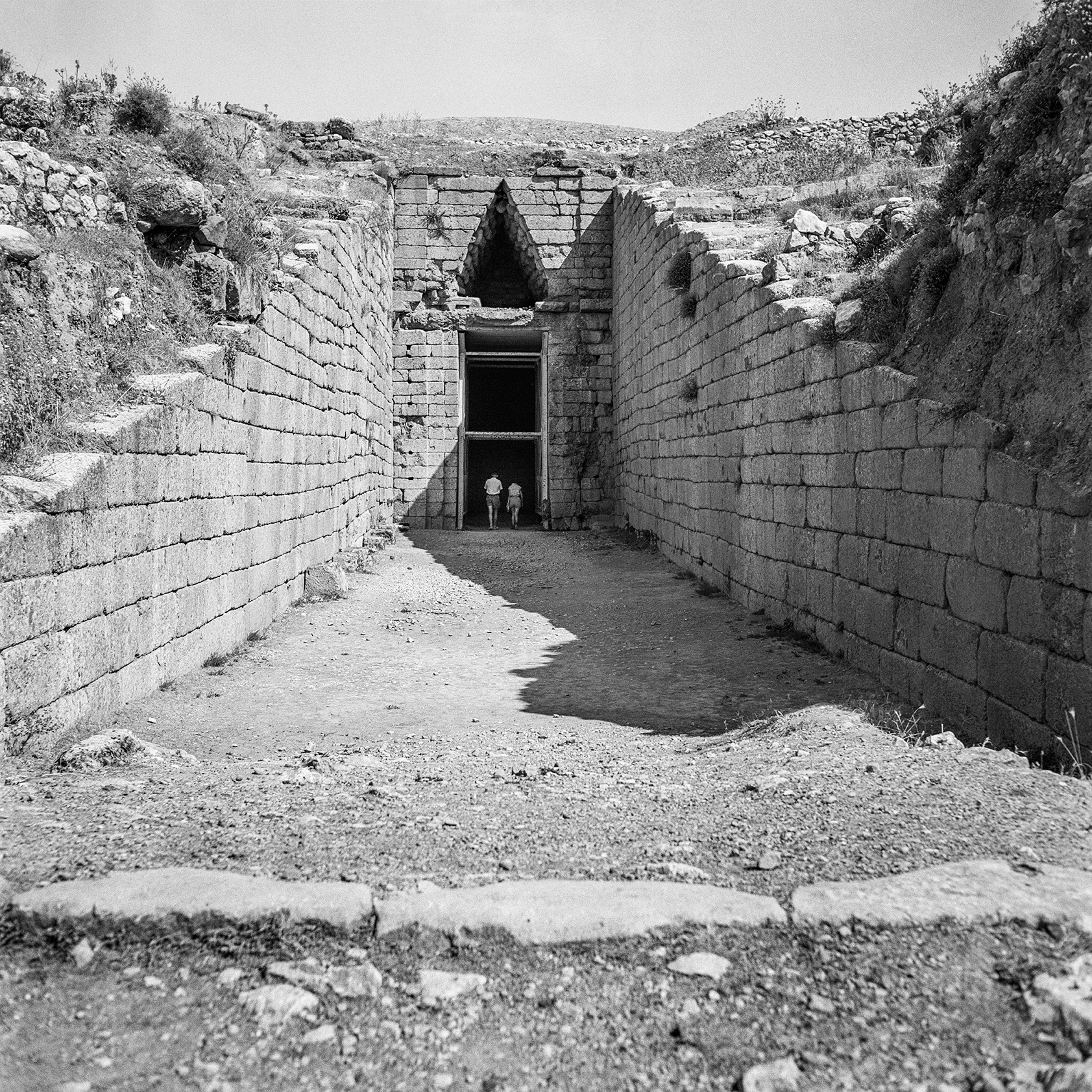
Tourists visit the Tomb of Clytemnestra, where the roof damaged by Veli Pasha in the early nineteenth century had recently been restored.
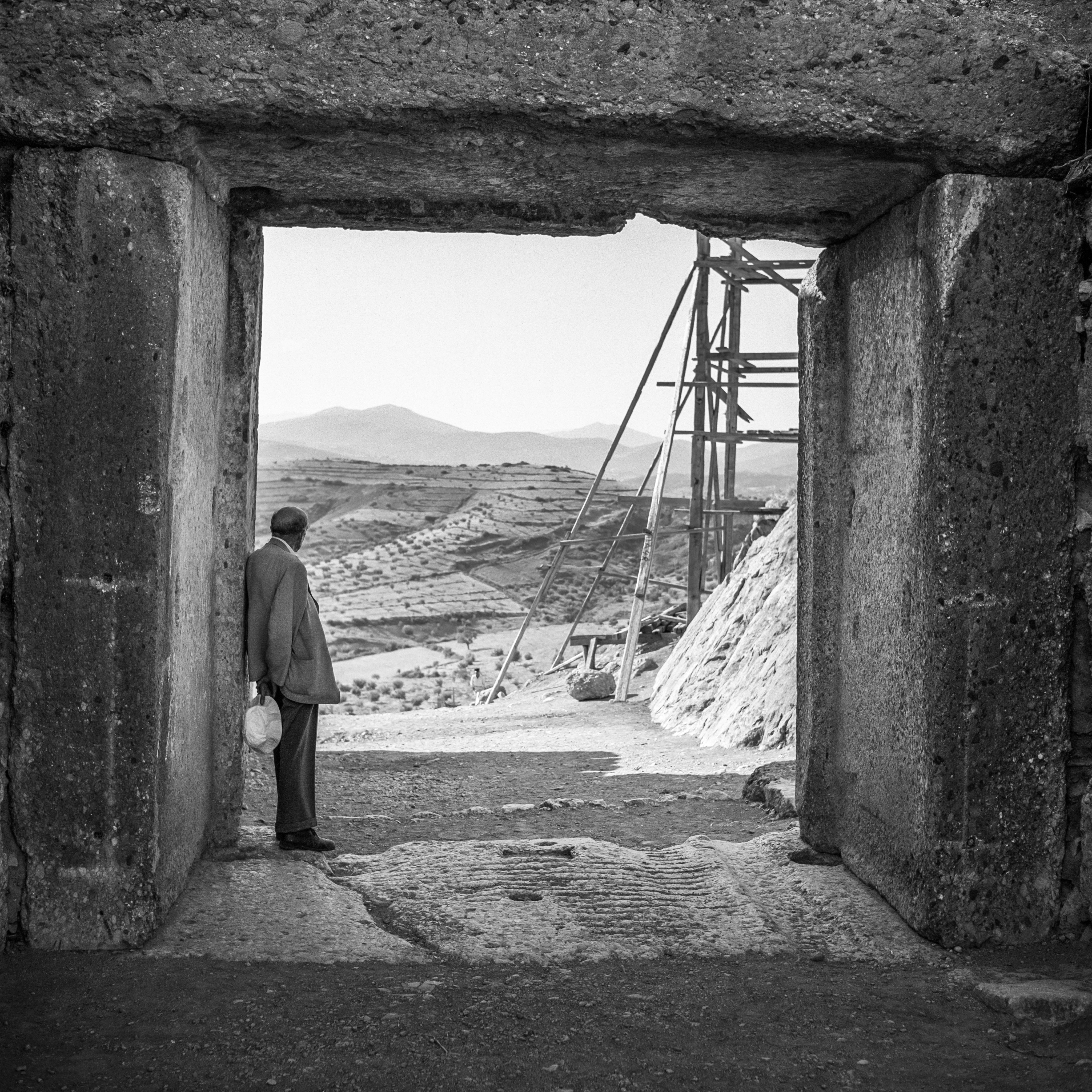
Above: Alan Wace looking out from the Lion Gate toward the roads leading north past some of the richest cemeteries of Mycenae.
Detail of the threshold of the Lion Gate. The deep channels, once thought to be wheel ruts from long usage are now considered more recent drainage channels. The crosscuts to stop slippage could be of any date.
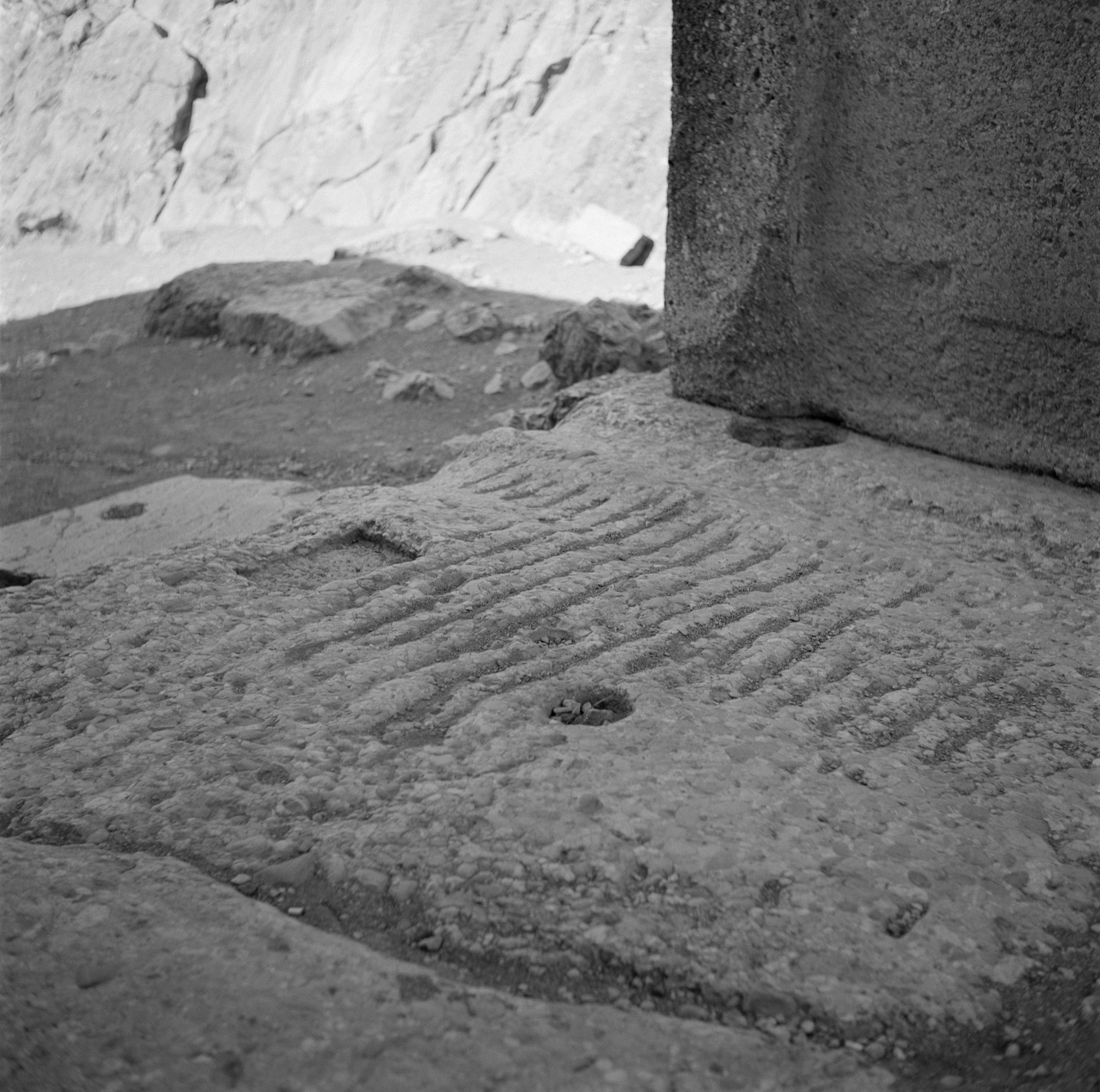
The Postern or North Gate from the inside.
Man sweeping on the hill above the village, possibly preparing a threshing floor or area for tobacco processing.
Detail of the corbelled dome of the Perfect tomb or the Genii tholos tomb.
Sophia Kolizera leads two horses along a road in the upper part of the village. The village of Mycenae (then called Charvati) moved in the early eighteenth century from the area of the current car park to its present site further to the south. When excavations resumed in 1950 after the German occupation and the civil war the village was very poor but thanks to imaginative aid – like the import of brood mares in foal – and the wages paid to the villagers who worked on the excavation, it soon started to flourish. The acropolis of Mycenae’s ancient enemy Argos is in the background, right.
Alan and Helen Wace at the far end of the dromos of the Treasury of Atreus
Cleaning a Hellenistic grave on the slope outside the Lion Gate.
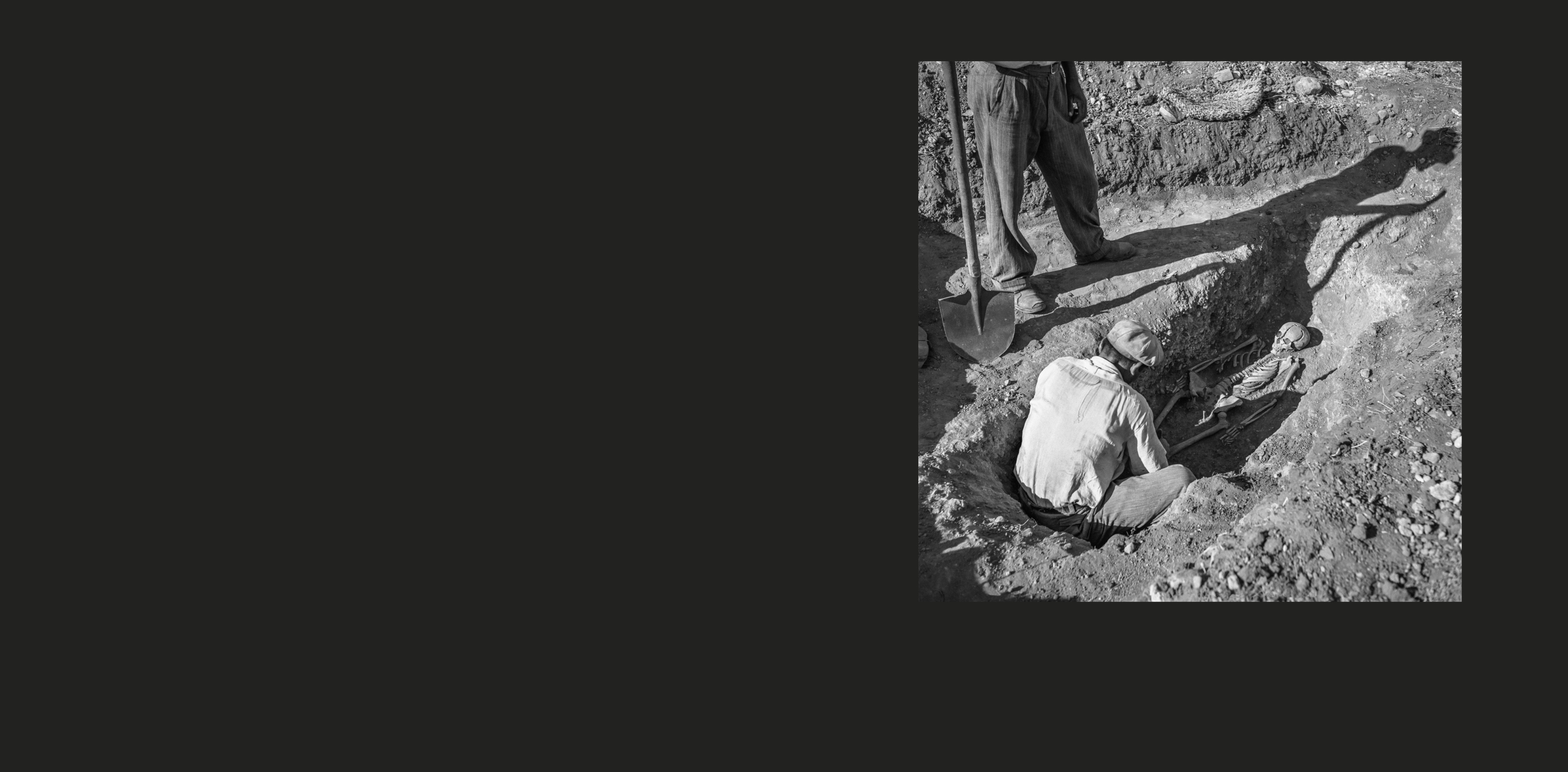
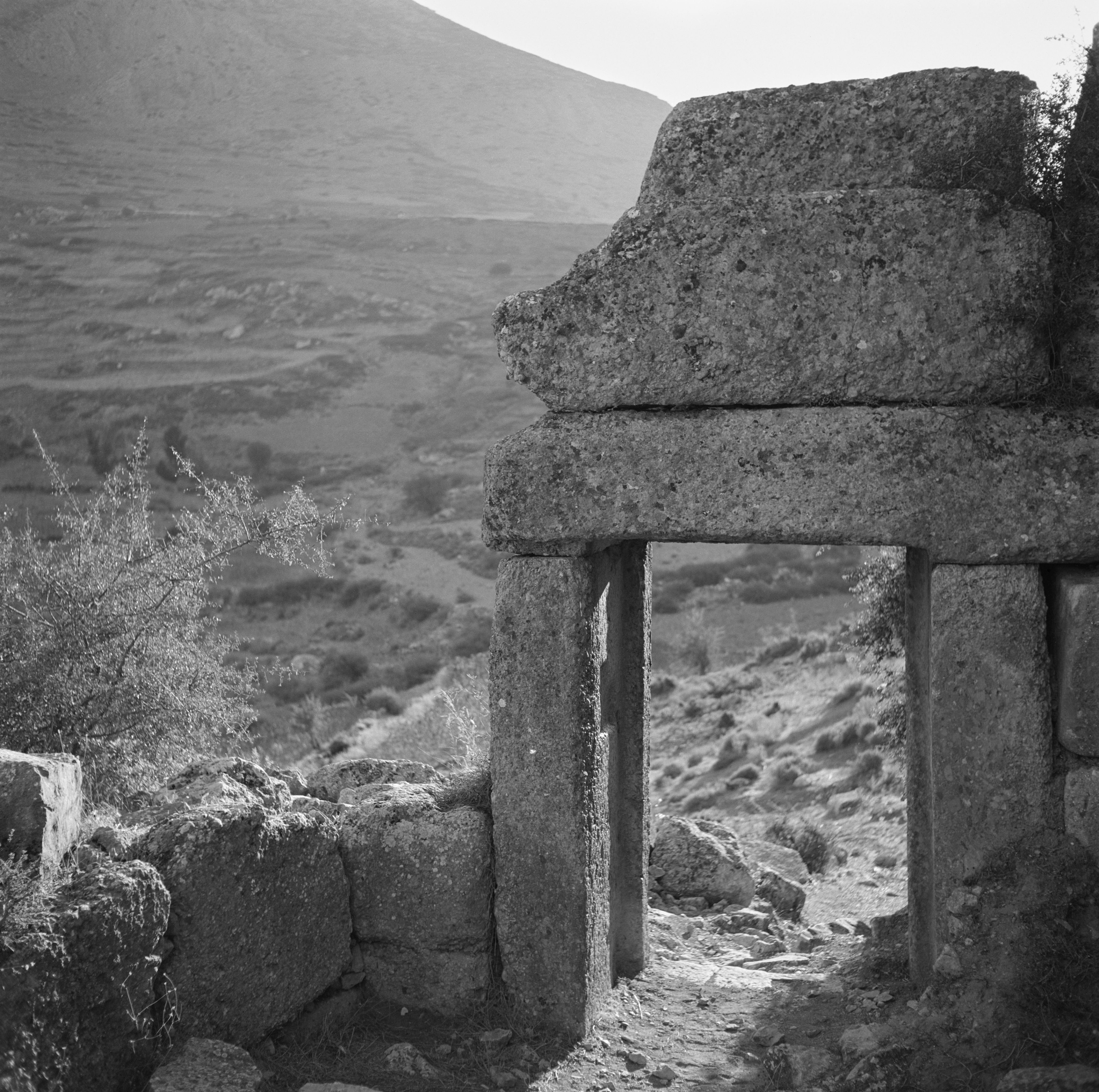
The Postern or North Gate from the inside.
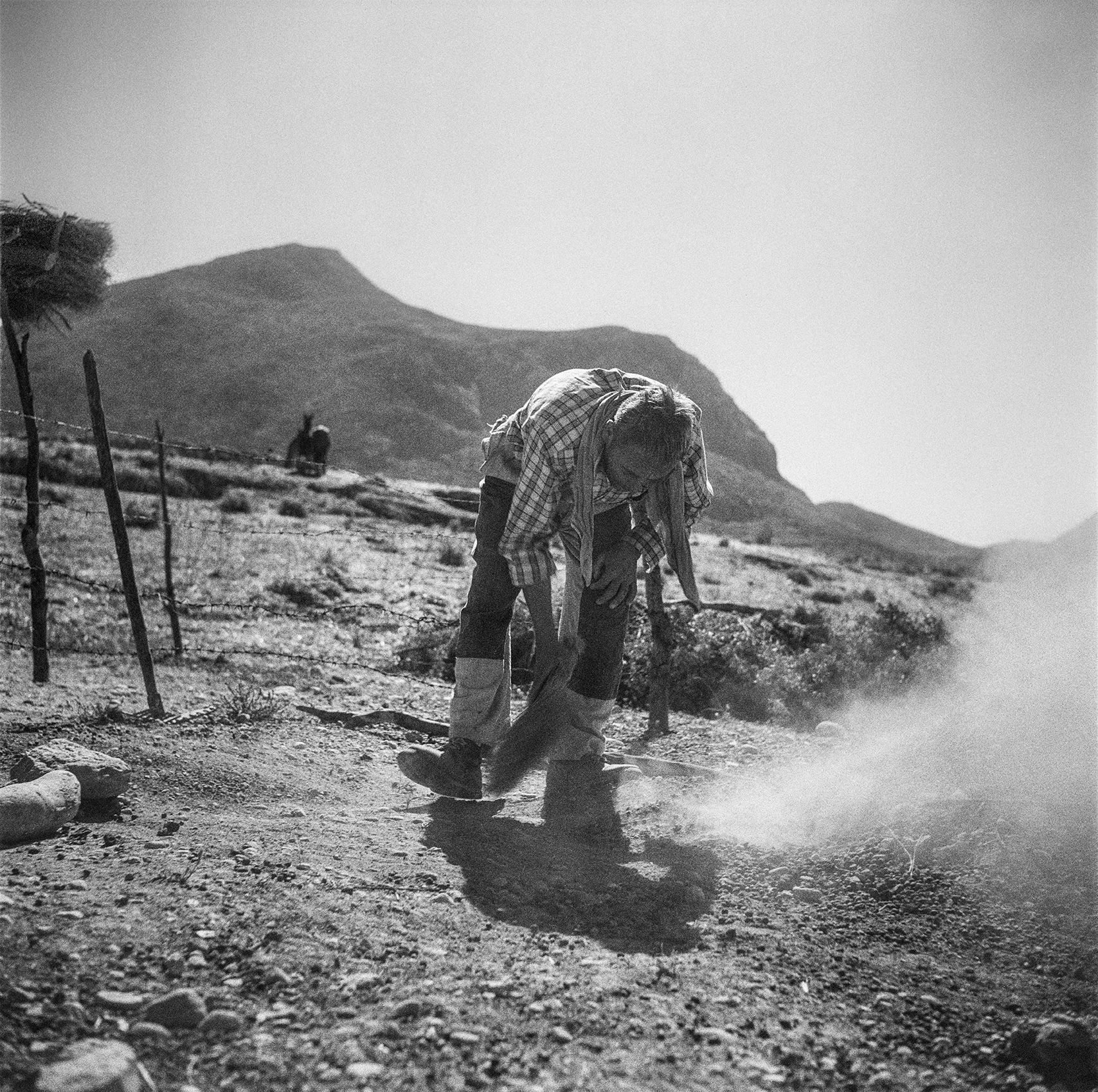
Man sweeping on the hill above the village, possibly preparing a threshing floor or area for tobacco processing.
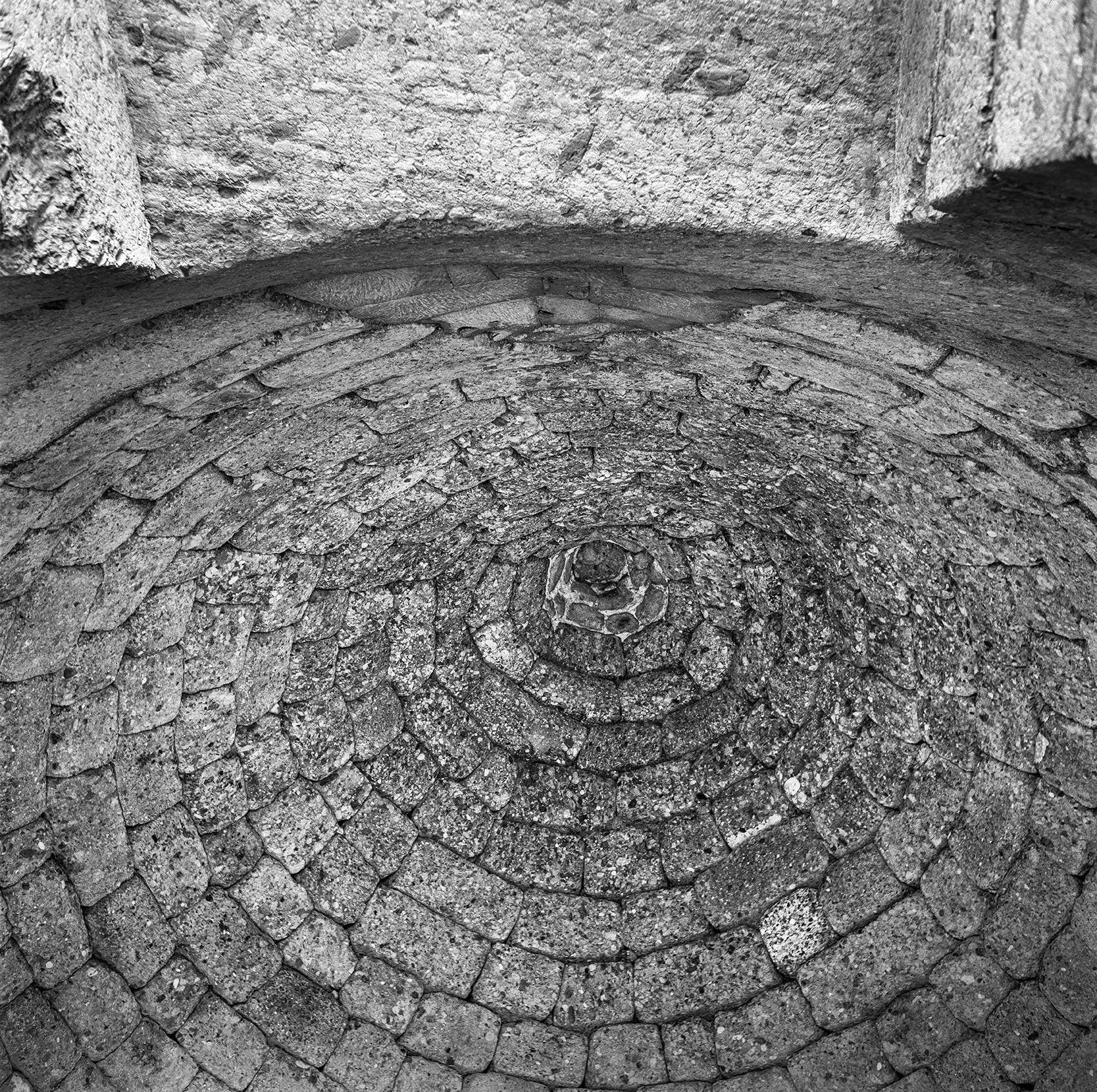
Detail of the corbelled dome of the Treasury of Atreus.

Sophia Kolizera leads two horses along a road in the upper part of the village. The village of Mycenae (then called Charvati) moved in the early eighteenth century from the area of the current car park to its present site further to the south. When excavations resumed in 1950 after the German occupation and the civil war the village was very poor but thanks to imaginative aid – like the import of brood mares in foal – and the wages paid to the villagers who worked on the excavation, it soon started to flourish. The acropolis of Mycenae’s ancient enemy Argos is in the background, right.
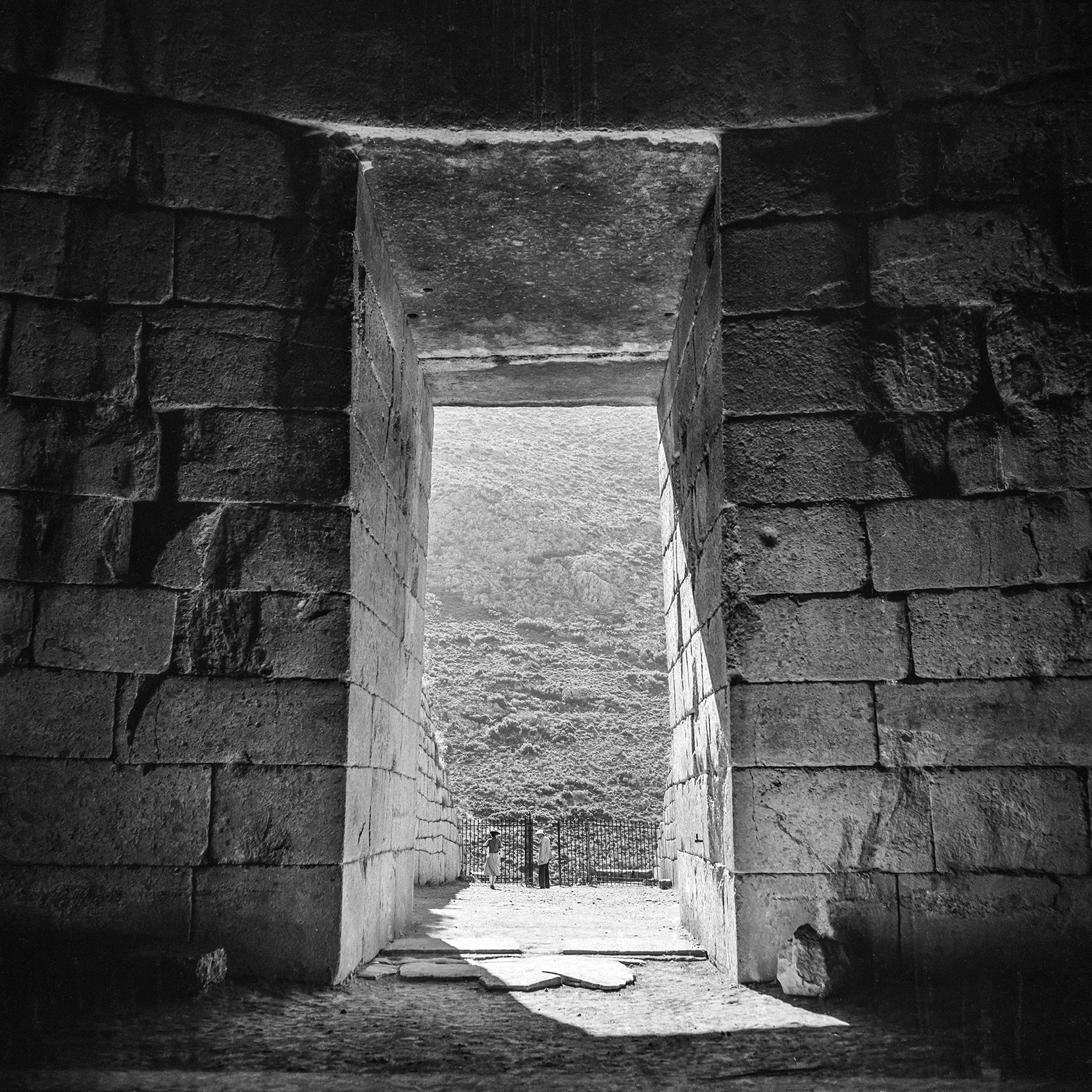
Alan and Helen Wace at the far end of the dromos of the Treasury of Atreus
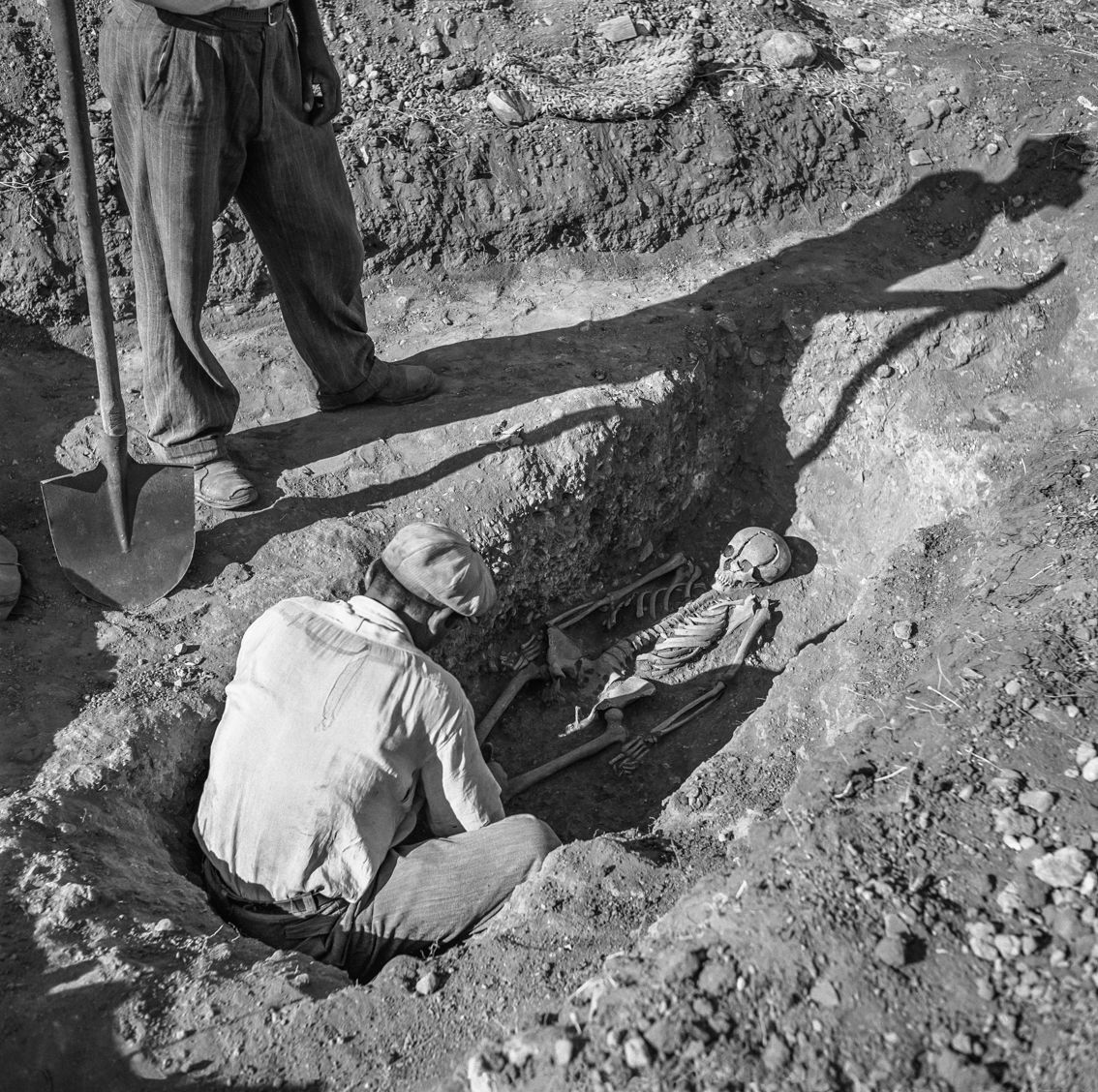
Cleaning a Hellenistic grave on the slope outside the Lion Gate.
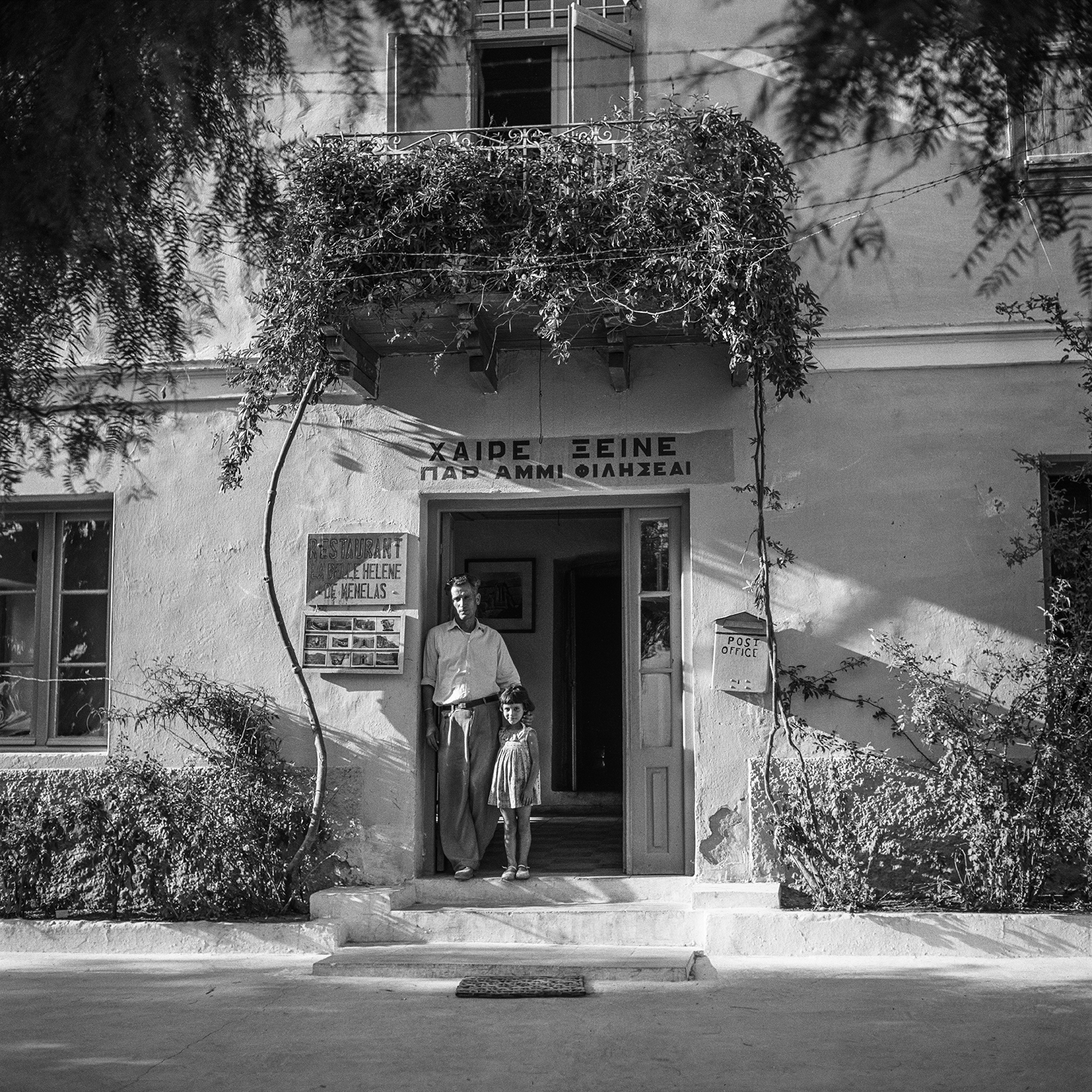
Agamemnon Dassis with his daughter Panagoula (Loula) at the door of the Belle Helene inn. Agamemnon was one of the four sons of Dimitris Dassis, excavation foreman for Professor Tsountas. The Homeric welcome over the door was first painted in the 1930s (and later repainted) by Peggy MacVeagh Thorne, daughter of Lincoln MacVeagh, American Minister to Greece from 1933-41.
His family, who were frequent visitors to Mycenae and featured the site in their delightful children’s book Greek Journey, gave major donations towards the building of the village church of St. Panteleimon.
The text (Odyssey 1.123) reads, “Greetings stranger. You will be welcomed here by us.”
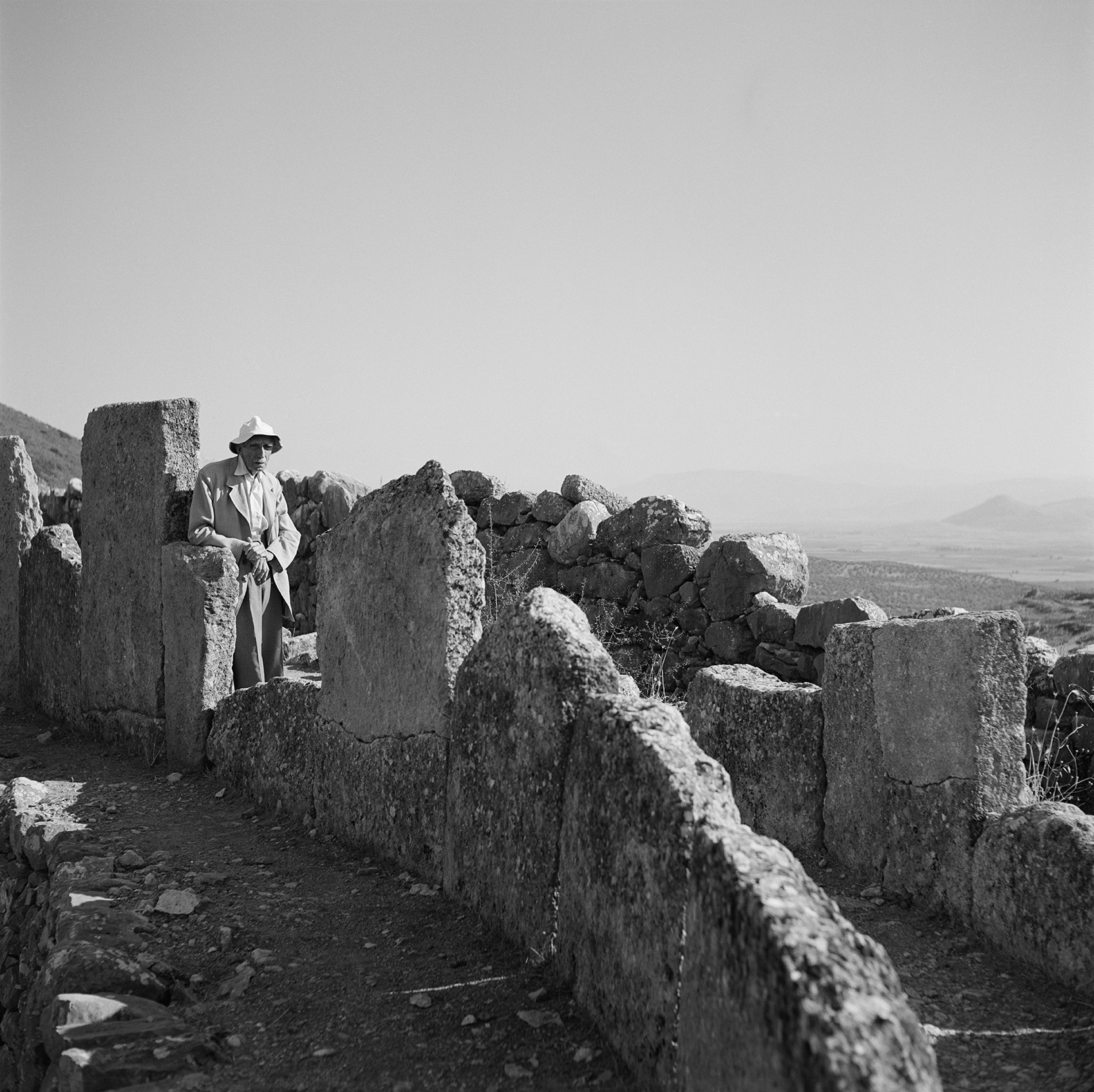
Alan Wace beside the orthostats of Grave Circle A. The Acropolis of Argos in the background.
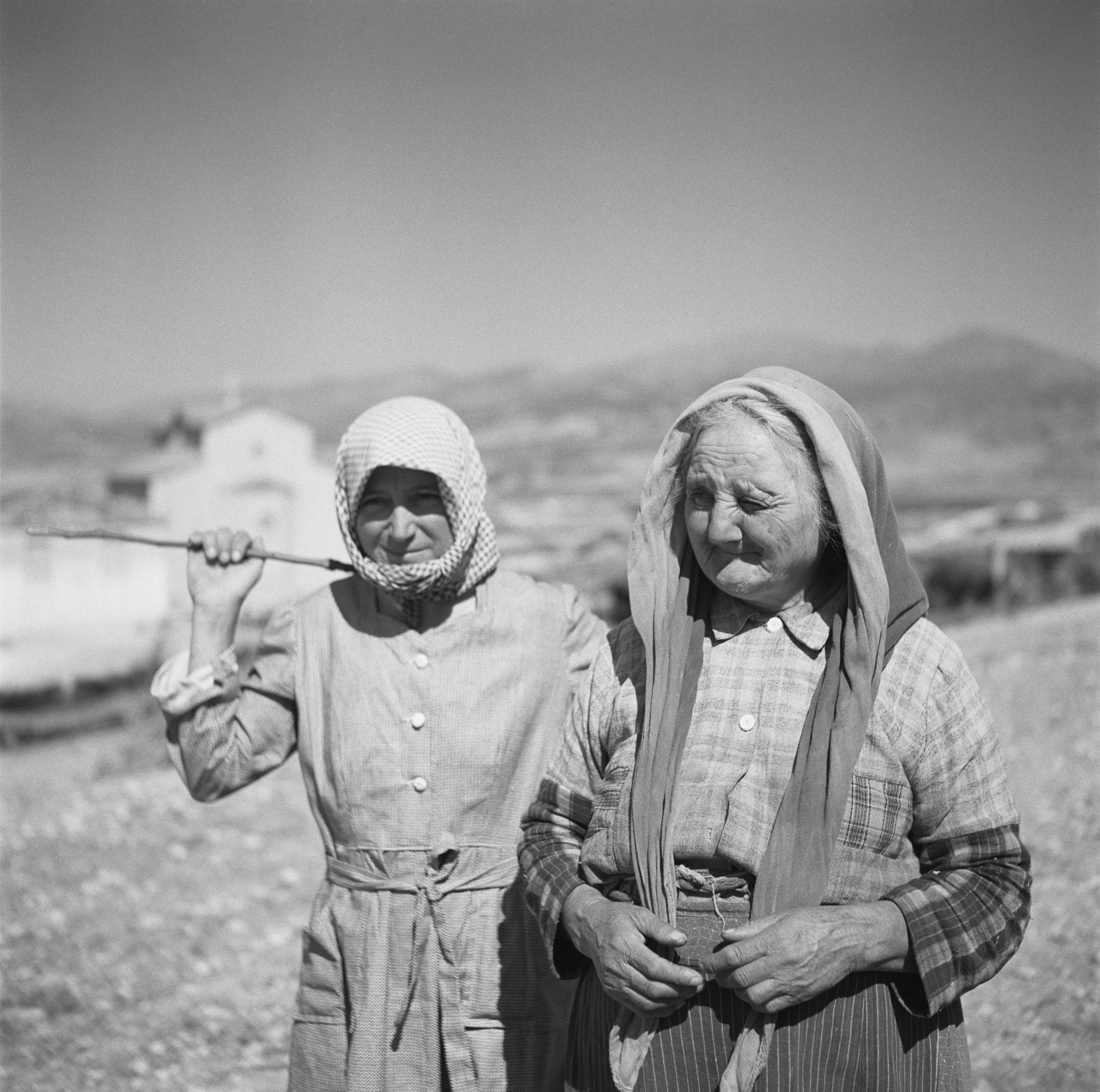
Two women, Marina Alonistioti and Vasiliki Chroni, from the village.
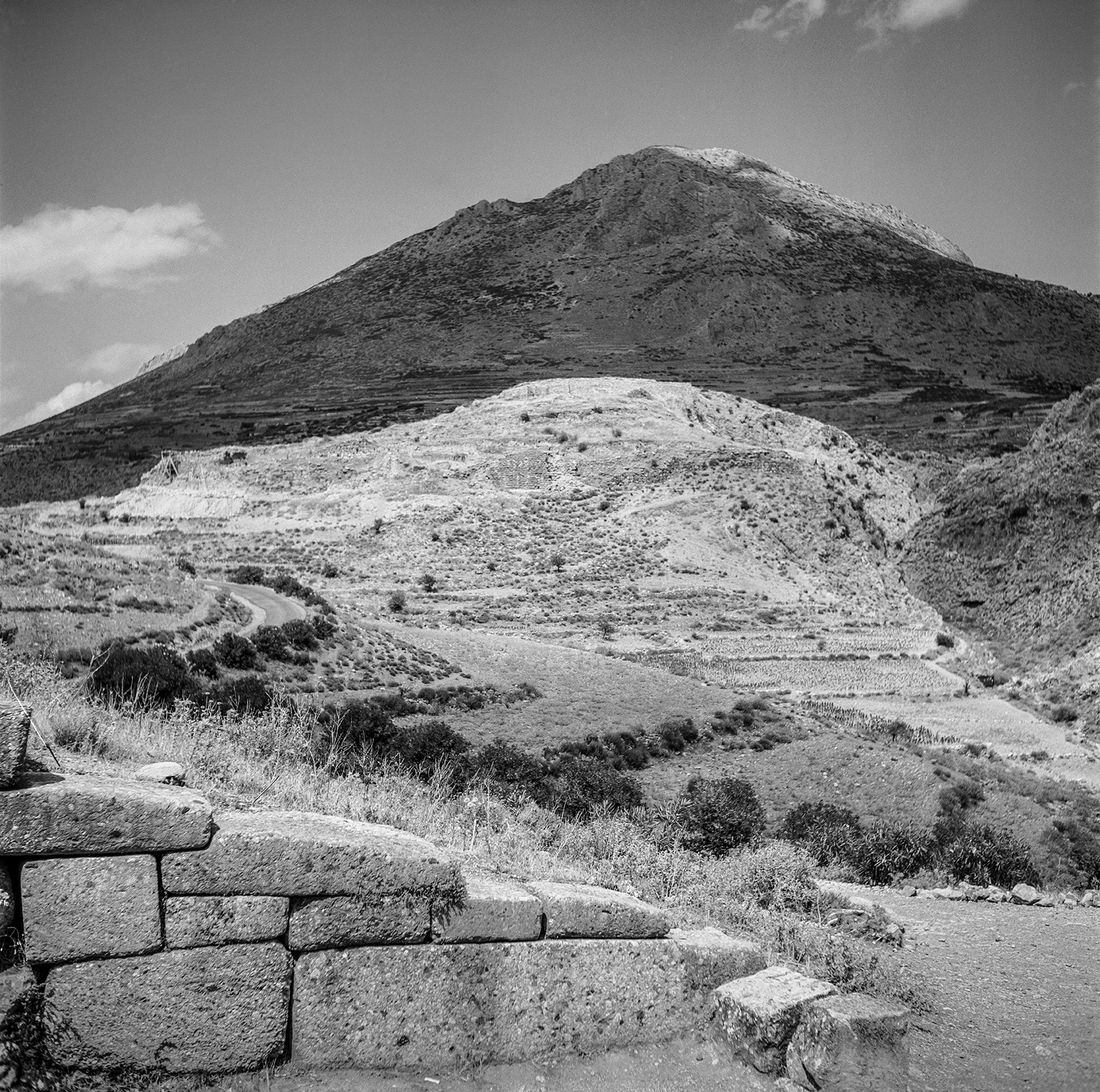
A passing cloud darkens Mount Prophet Ilias behind the sunlit Acropolis, seen here from the entry to the dromos of the Treasury of Atreus.
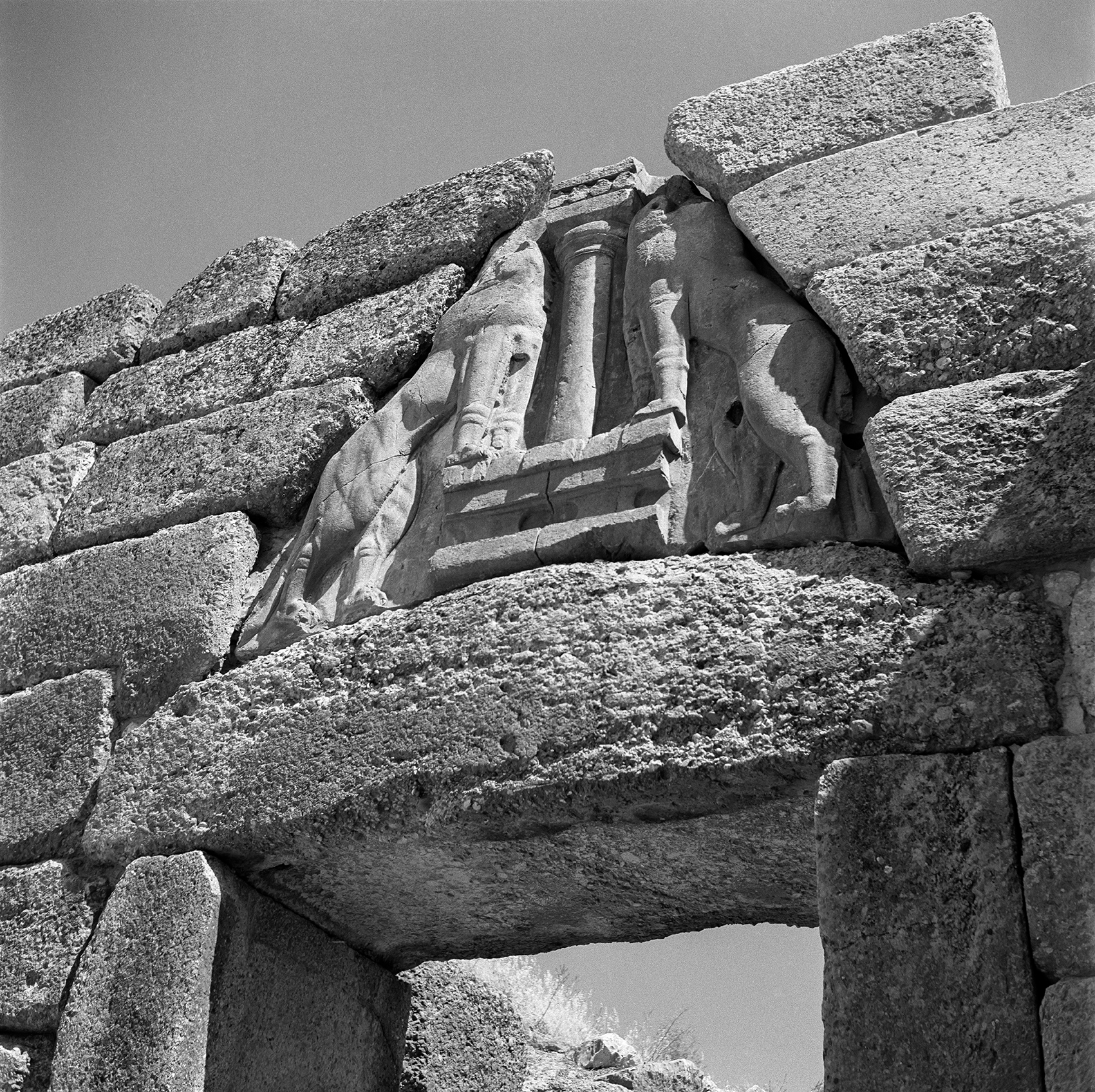
The lion relief over the main gateway to the Acropolis of Mycenae.
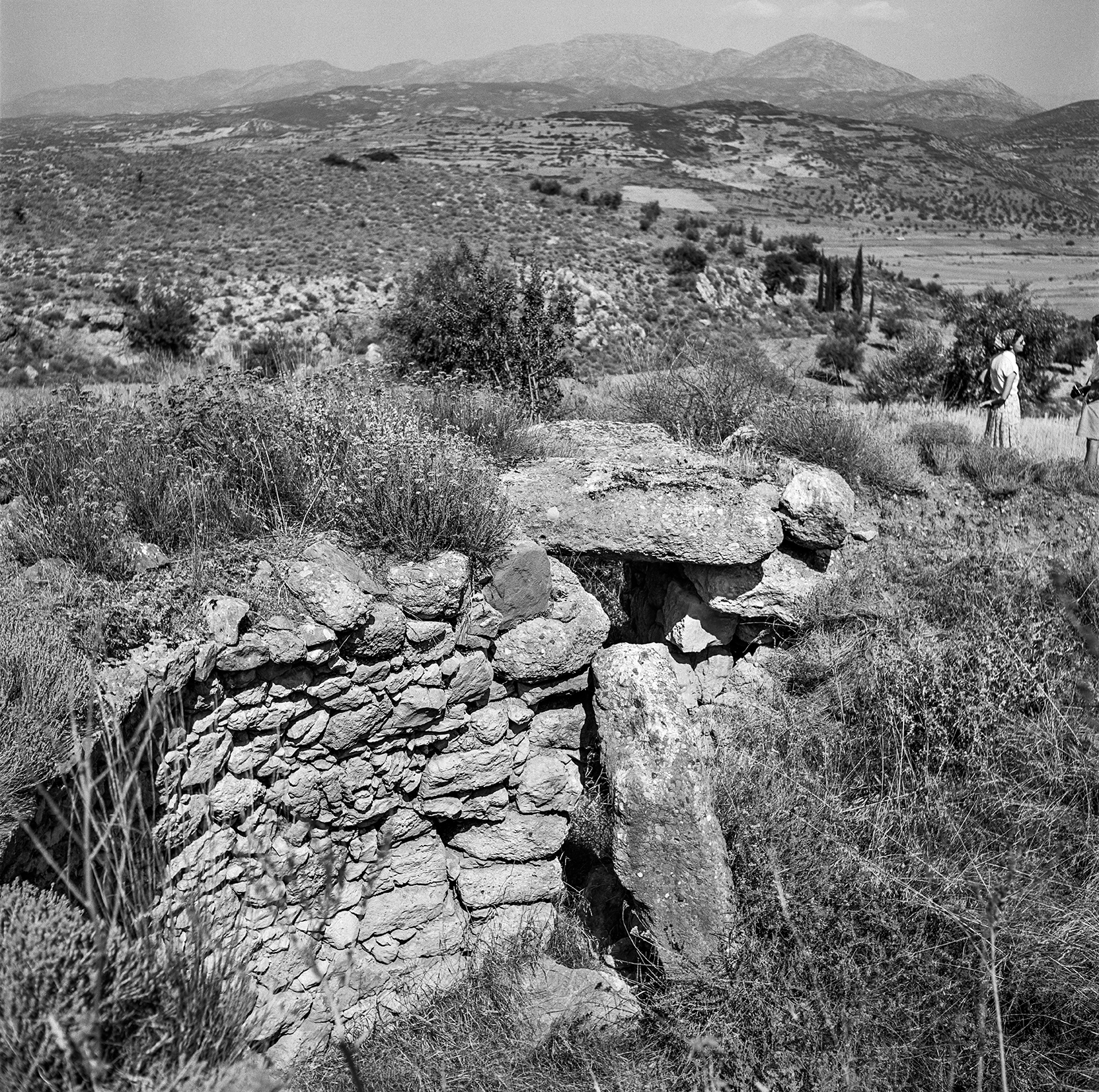
Lisa Wace French and a fraction of Charles Williams at the Cyclopean Tomb.
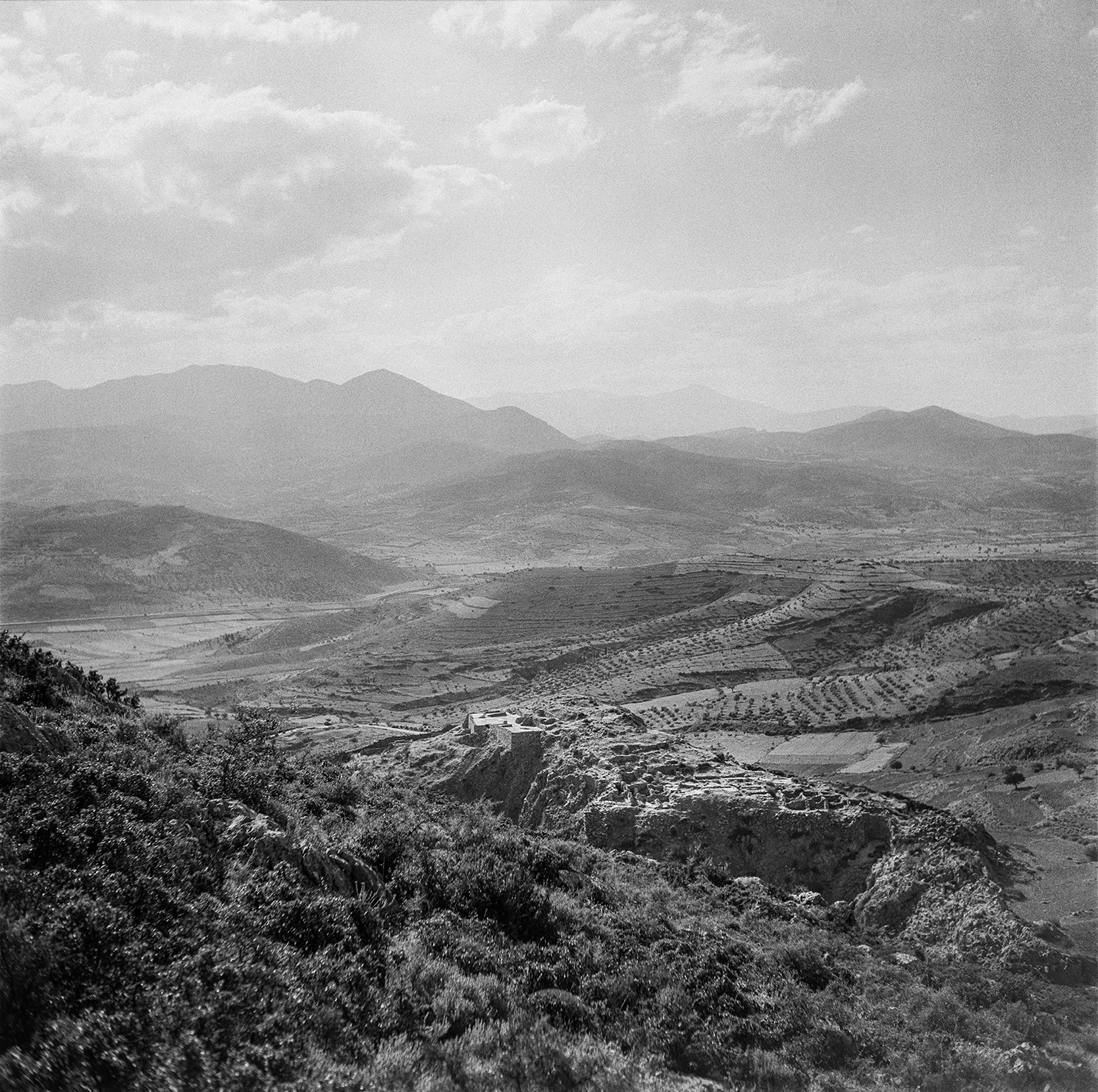
From high on rugged Mount Zara – not often climbed – there is an unusual view of the Acropolis from the northeast. The newly restored terraces, which held up the Court and Megaron complex of the Palace, show starkly. Mount Kyllene, the birthplace of Hermes, can be seen in the distance to the southwest.
Lisa Wace French and Charles Williams wait for this photograph to be taken from inside the Tomb of the Genii (sometimes called the Perfect Tomb for its excellent state of preservation).
Looking out along the dromos of the Treasury of Atreus from the level of the lintel; Helen Wace scurrying to get out of the photograph.
The southwest extremity of the Acropolis in the early morning light, silhouetted against the shadow of Mount Zara with the Argive plain beyond.
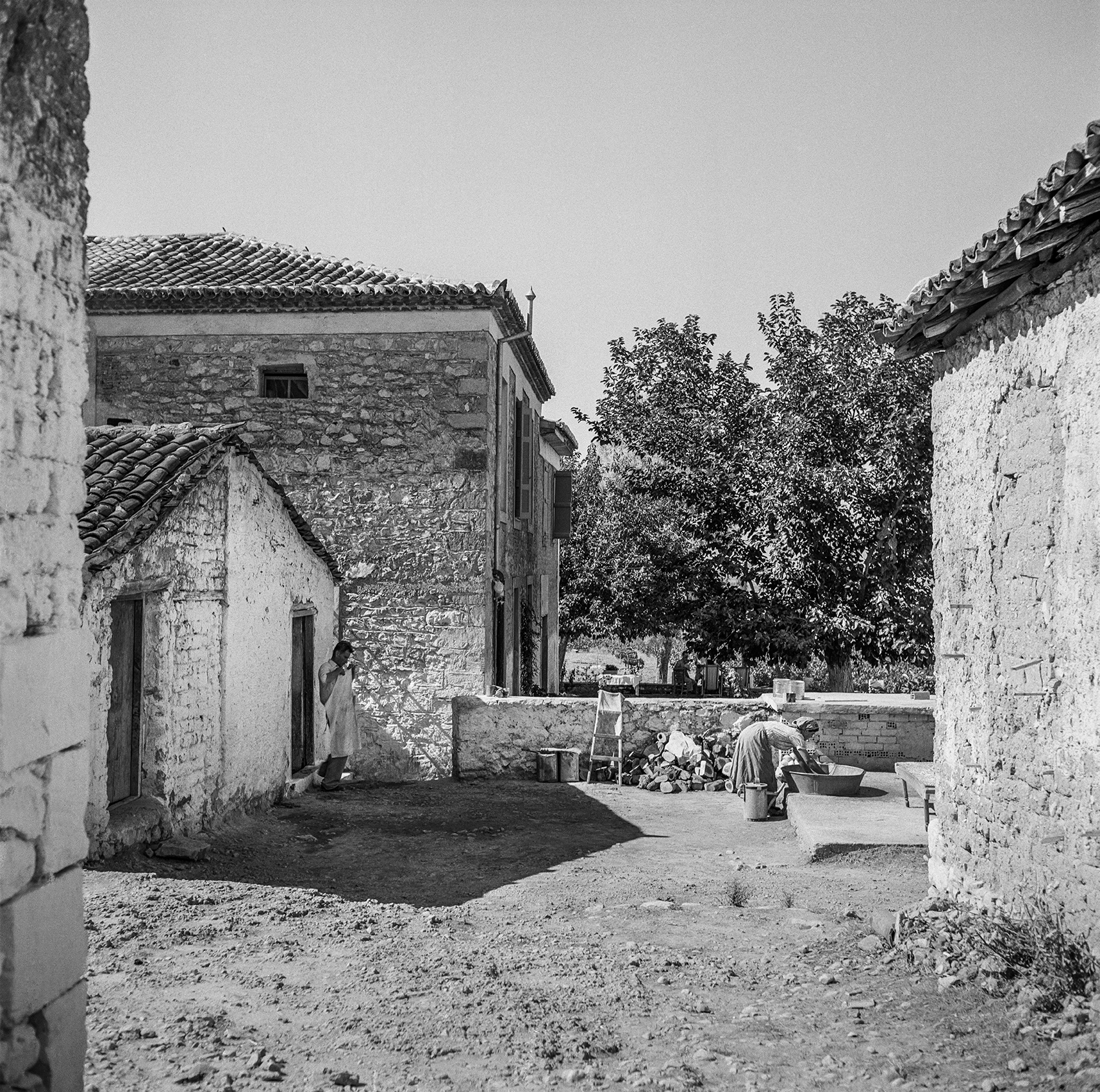
Beside the kitchen block behind the Hostel Belle Helene with Agamemnon Dassis in a cook’s apron at the door and his wife Vassiliki (Vasso) doing laundry. The deckchairs of Alan Wace’s excavation team can be seen under the pepper trees in the front yard. Orestes, a younger brother, was the usual cook but he also served as an excavation foreman.The side of the original front section of the inn can be seen; this was later destroyed to build the current large front reception area needed to cater to the coach parties that visit the site.
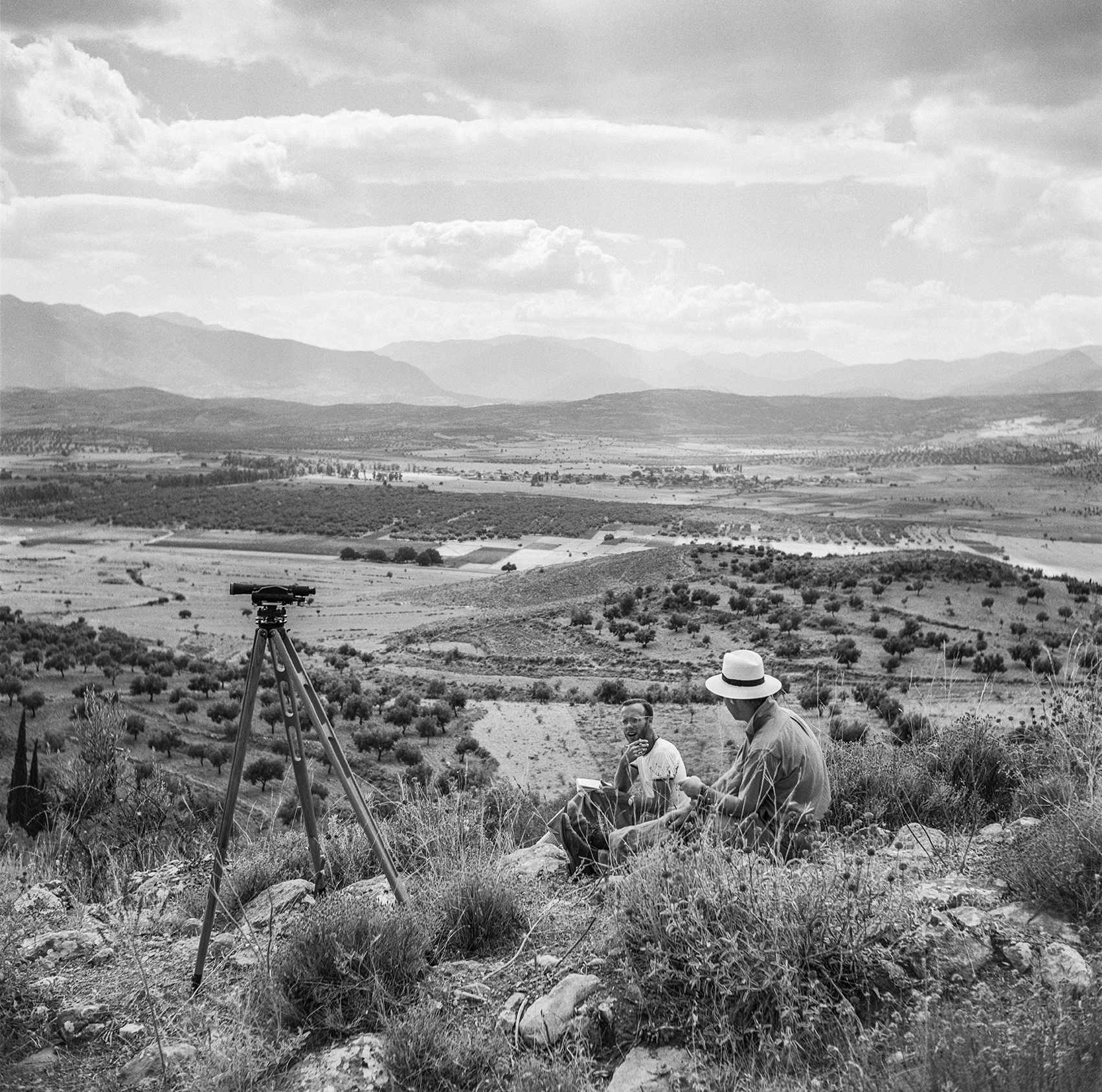
At the south end of the Panagia ridge Charles Williams (excavation architect 1955) discusses the excavation with the trench master of that area, Reynold Higgins (of the British Museum, later Chairman of the Managing Committee of the British School). The basic “dumpy level” set up for use in surveying the area is very different from the “total station” that would be used today. But the results would be much the same.
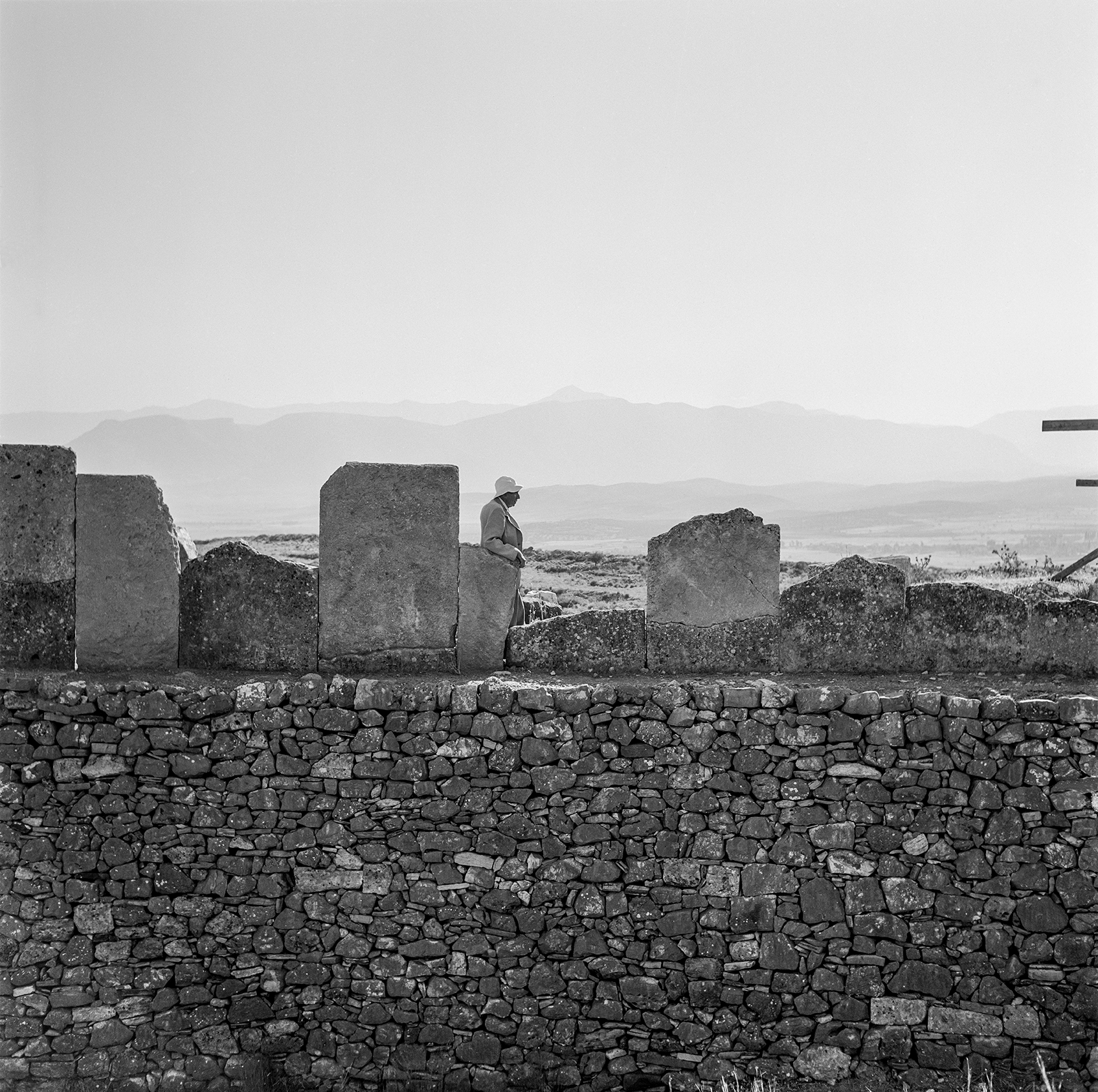
Alan Wace looking out across the Citadel Wall toward the merchant’s houses and the terrain to the northwest from the surround wall of Grave Circle A. This is the Grave Circle discovered by Schliemann and from which the fabulous gold objects form a prime display in the National Archaeological Museum in Athens. The discovery in 1951 of a second Grave Circle slightly earlier in date has required the two circles to be distinguished by the addition of the letters A and B to the titles by which they are known.
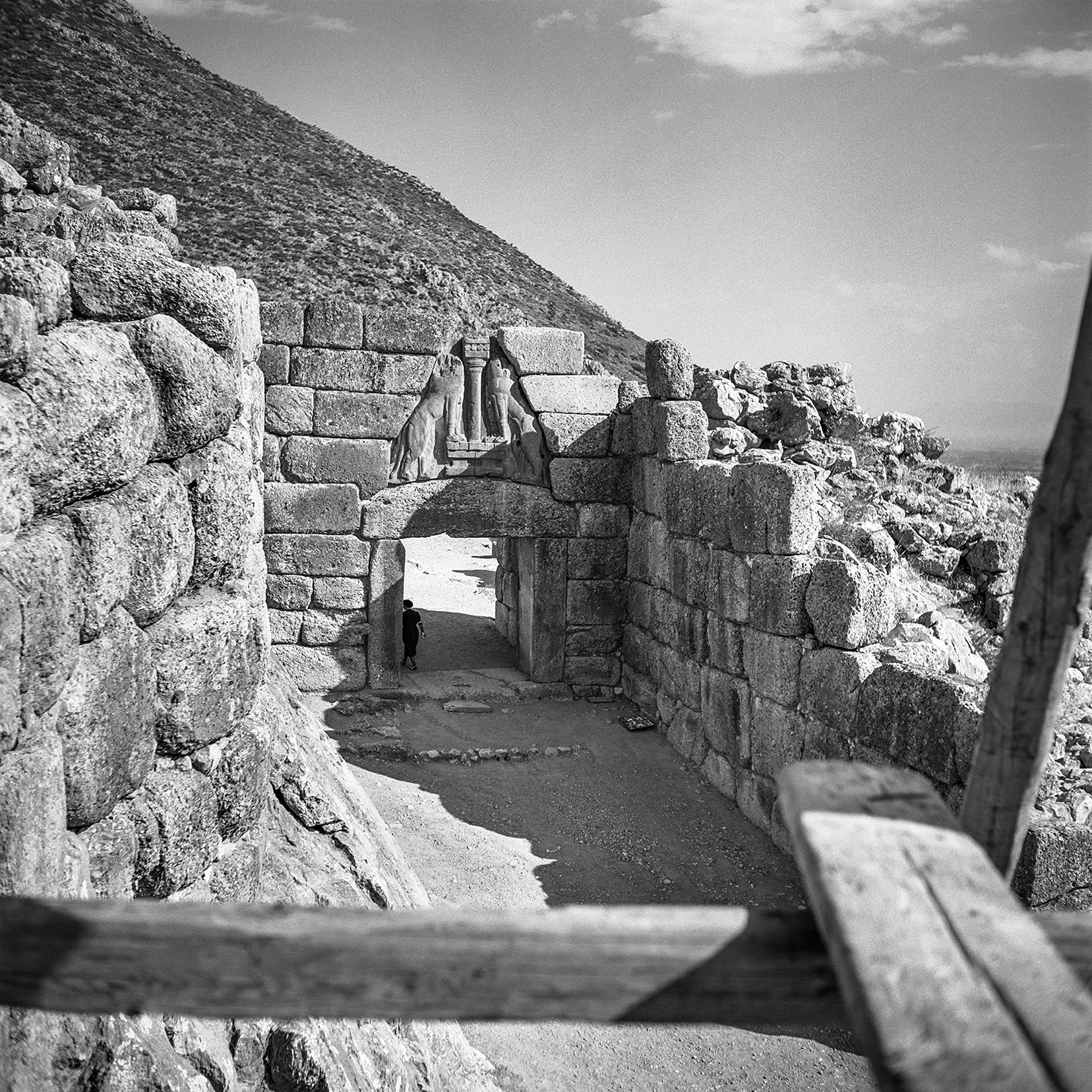
The Lion Gate and its entrance passage seen from the scaffolding of the restoration work on the east wall.
Acknowledgements
Robert McCabe would like to thank museum staff: Dr Yannis Galanakis and Dr Susanne Turner for curatorial support, and Sade Ojelade for graphic design.
The captions were written by Lisa Wace French for the publication Mycenae: From Myth to History, the driving force behind which was Athina Cacouri, without whom the book could not have been written.
For the physical exhibition scans, editing and printing were undertaken by George and Sophie Marinos at Idolo Lab, and mounting by Constantinos Karasaviddis.
Oversized images were prepared and printed by AVMG, Cambridge.
The Museum would like to thank Robert McCabe for kind permission to reproduce his images and tireless support for the exhibition, despite the delays caused by the pandemic.
Transportation was kindly supported and undertaken by Aegean Airlines.



